The White Indians of North and South America – Resets and Genocides, Part 4
(Part 4 of a 14 Part Series)
Sections:
Introduction
Explorers / Publications and their depictions of the New World American Indians – Focusing on The Great Voyages publications:
- John Smith Maps
- Sir Walter Raleigh’s Expedition (Thomas Harriot’s account) – Virginia – North America
- René Goulaine de Laudonnière Explorations – Florida – North America
- Hans Staden – Brazil – South America
- Girolamo Benzoni – Greater Antilles (Caribbean etc) and South America + Columbus
- Amerigo Vespucci – South America (Including local Islands and Amazon River)
Behaviour and Culture of the New World American Indians
The Colouring of De Bry’s engravings
Other artists and publications depictions of the New World American Indians:
- Simon van de Passe – Portrait of Pocahontas
- Wenceslas Hollar
- Ulrich Schmidl
- Samuel De Champlin
- Joseph-François Lafitau
- Jacques Grasset de Saint-Sauveur
- Thomas Salmon
- French Engraving 1700s
- Campanius ‘new sweden’
- Patrick Gass
- Ponce De leon
- Sylvain Marechal
- Pierre Desceliers’ Map of 1550
- Nicolas de Larmessin
- 1800s illustration of Colombus landing in the Bahamas
Concluding Thoughts
Additional Information:
- Laudonniere commentary on the Floridian Natives
- Columbus commentary on the Indians he encountered in the Indies + Spanish Brutality
- Gallery featuring the native Nicaraguans, Orinoco people, Morquito People, Ottawans, Caribs, Panamanians, Venezuelans
- The Aztecs and The Incas
- More Jacques Grasset De Saint Sauveur Images
- Dutch New World Expeditions (Tierra Del Fuego etc)
- Some Useful Links
Introduction
I have discovered a great deal of evidence that the Indians encountered by Europeans in their exploration of North, Central and South America in the 1500s and 1600s where White / Caucasian. Mainly consisting of very tall White humans, possibly around 7 to 8-foot-tall in the main. As well as some even taller White giants, and some ‘regular’ sized White humans (close to our size). I know the programming will be strong, and some may be resistant to this information, but I found all these artists and publications listed above depicting the American Indians as tall, White, often fair-haired (red, blonde and brown hair in the main… and some black haired White people in South America) and muscular. I am actually somewhat shocked no one else has noticed this, the evidence is overwhelming, but then again, I should not be surprised with the huge number of gatekeepers and controlled opposition agents out there.
In my ‘Ancient Giants’ article (Part 1 of this series) I discussed the White (Caucasian) Lovelock Cave giant skeletons, the White (Caucasian) Catalina Giant skeletons and the red and fair-haired, White (Caucasian) Floridian, Haplogroup X, bog mummies – which were all found in North America. I also discussed the incessant cover up that has been occurring by the Smithsonian Institute: Monitoring all discoveries of skeletons in North America and then getting to the excavations to confiscate bones and artefacts before analysis can be done.
Below is a gallery containing a selection of images of the native people of North America, South America and the Caribbean Islands created by artists / illustrators in the 16th, 17th and 18th centuries. Additional information on many of these images – such as the publications they featured in and in which expeditions the people were encountered – will be displayed in the rest of the article. There are a great many more images in the article beyond this small gallery.
Dates of images: Ranging from Images created in the very early 1500s to images created in the late 1700s (and one from the 1800s). Nearly all these images below are from different artists, and all are from different publications:
Some of the artists featured in the gallery:
- John Smith / William Hole
- Theodore and Johann De Bry
- Jaques La Moyne
- Joseph Francois Lafitau
- Samuel De Champlain
- Wenceslaus Hollar
- Simon van de pass
- Thomas Salmon
- Campanisu ‘New Sweden’
- JG de Saveur
Gallery
These are Thumbnails – click to enlarge.
Note: After the last Website Update the galleries are all playing up. If it is not displaying properly, if you refresh the page twice it will work just fine. I will endeavour to rectify this as soon as possible.
No one in the 1400s, 1500s, 1600s or 1700s was depicting Native Americans as short, skinny, dark-skinned people with straight black hair. It was in the 1800s, that we started to get depictions of small, thin ‘Red Indians’ with straight jet-black hair and dark skin as the Native Americans. It seems incredible to me that no one has noticed this before. But humans have been so shut down, kept so busy, so mind controlled… and ‘The Powers That Be’ have installed gatekeeping, controlled opposition agents everywhere.
You may want to read my previous articles on Ancient Giants, European Nobility (and Celts and Gauls) and The Tartarians (and Ottomans) before this one. In the article on European Nobility, I show how Europe in the 1400s, 1500s and 1600s was dominated by tall red heads (as well as some reddish-brown hair, and lighter more blondish hair, but in the main red-heads). Europe was ruled and dominated by humans over 7 feet tall in these centuries. In the medieval period us ‘regular’ humans were significantly shorter. Males in Europe around 5 foot 5 inches and females around 5-feet-tall. It was not us smaller humans going on these expeditions to ‘The New World’, but the significantly taller upper classes of Europe. I realise this may bring up many questions, and some cognitive dissonance, but to understand it all you should read all the articles in this ‘Resets and Genocides’ series.
The most famous engraver / artist / publisher related this topic is Theodore De Bry. He created many images of the White Native Indians, as well as images of people in Africa and Asia. His family (children and son in law) also printed many more books documenting various explorers’ experiences after his death.
There has also been some orchestrated subversion to muddy the waters by ‘The Powers That Be’. Some subversive water-colour illustrations supposedly turned up in 1984, which I will analyse and expose.
We will start with some of the most famous expeditions, and explorers, and then look at the numerous other images and depictions.
John Smith Maps
Two maps in this book ‘The General History of Virginia, New-England, and the Summer Isles’ (1624) with images of the Indians of North America surrounding the maps:
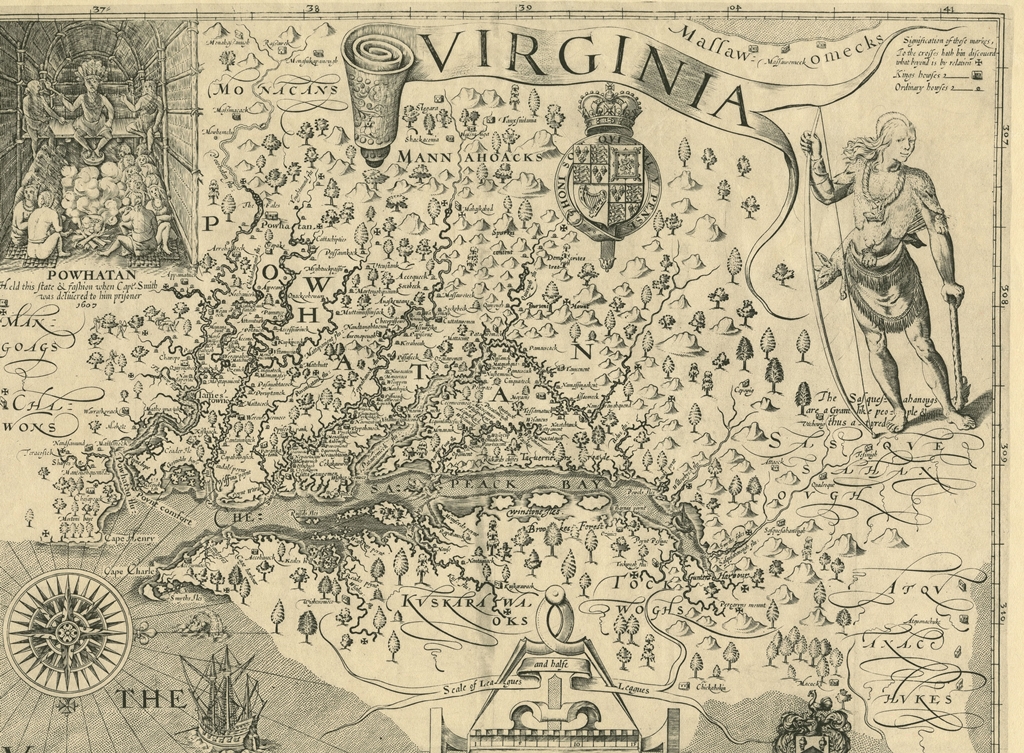
“This map of colonial Virginia, attributed to Captain John Smith, one of the first English settlers, contains extraordinary geographic detail as well as the locations of Indian settlements. The area on the map defined as “Powhatan” is where the Algonquian-speaking Indians allied with the paramount chief known as Powhatan lived. An image of Powhatan in his hut, at upper left, is based on Smith’s description of what he encountered when he was delivered as a prisoner to the chief in December 1607. The Chesapeake Bay and four major rivers are also depicted: the Powhatan, Pamunk, Tappahannock, and Patowomec (now the James, York, Rappahannock, and Potomac, respectively). The English settlement at Jamestown (“Iames’-towne”) is shown in a curving section of the Powhatan River at far left.
Engraved by William Hole, the John Smith map was the most comprehensive charting of the region up to that time. It was first printed in 1612 and later published in Smith’s book The General History of Virginia, New-England, and the Summer Isles (1624), which is the version shown here. As indicated by the compass rose at lower left, the map is oriented with west (rather than north) being at the top. Many early maps were oriented in that direction, and it showed how the area looked when approached by ship from western Europe. The John Smith map was the definitive map of Virginia from 1612 until 1673.” https://encyclopediavirginia.org/744hpr-24d5af2b9837969/
Below are close ups of the two images on the map:

The second map by John Smith in the book, The General History of Virginia, New-England, and the Summer Isles (1624):
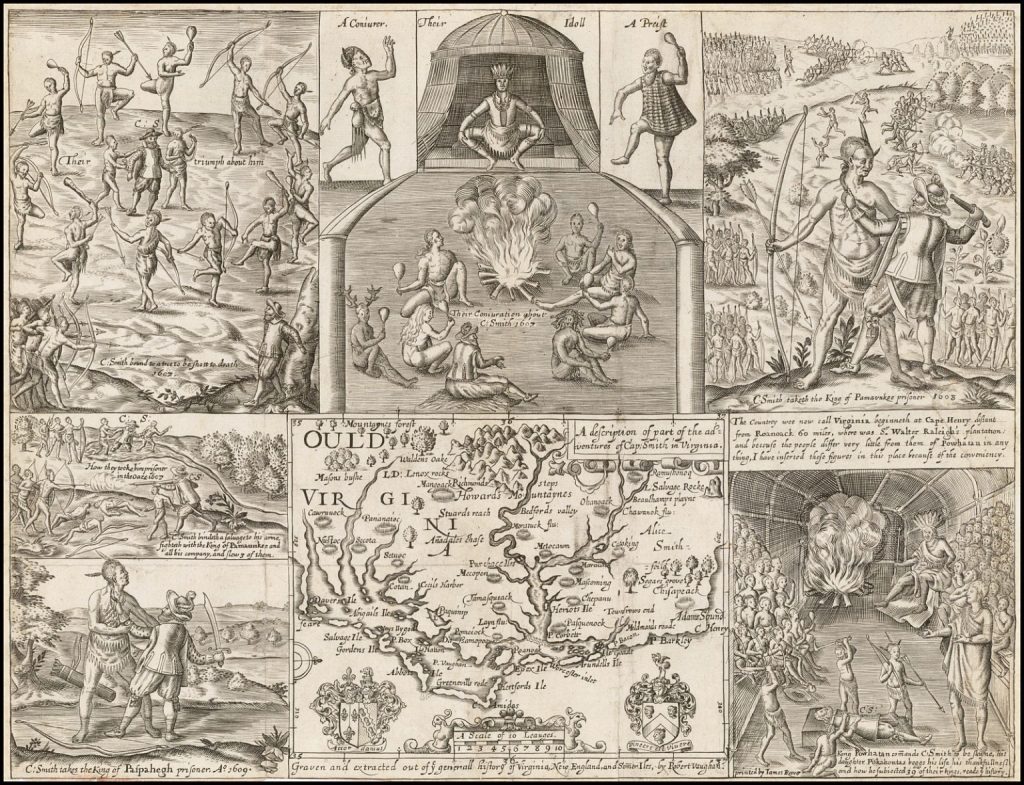
Close ups of the images on the second map:
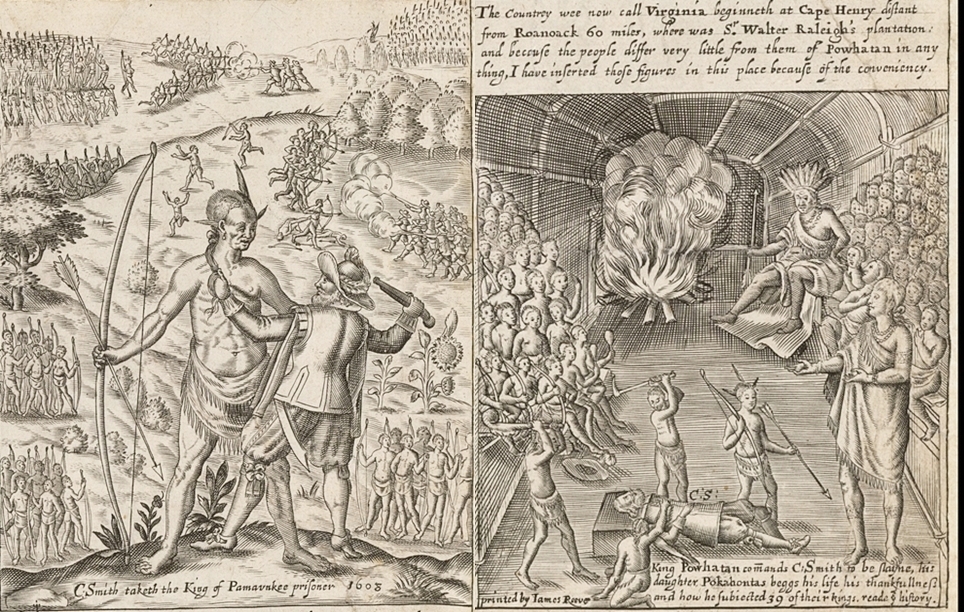
Above Image: These smaller Indians, above on the right, could be genetically the same people as the 5-foot 2-inch to 5 foot 8-inch Red-Headed (Haplogroup X) Florida Bog Mummies that were found in North America. There is information about them in Part 1 of this series. It is very likely that in the Americas – just how it was in ancient Europe – there was 5-foot plus humans, 7-foot plus humans, 9-foot plus humans, as well as some particularly large giants, that were much less numerous. Also, like how it was in Europe, before sometime in the 1700s, the roughly 7 feet-tall to 8 feet-tall humans were the most numerous. If you have not read the first 3 parts of this series of articles, then this information may sound somewhat confusing or odd.
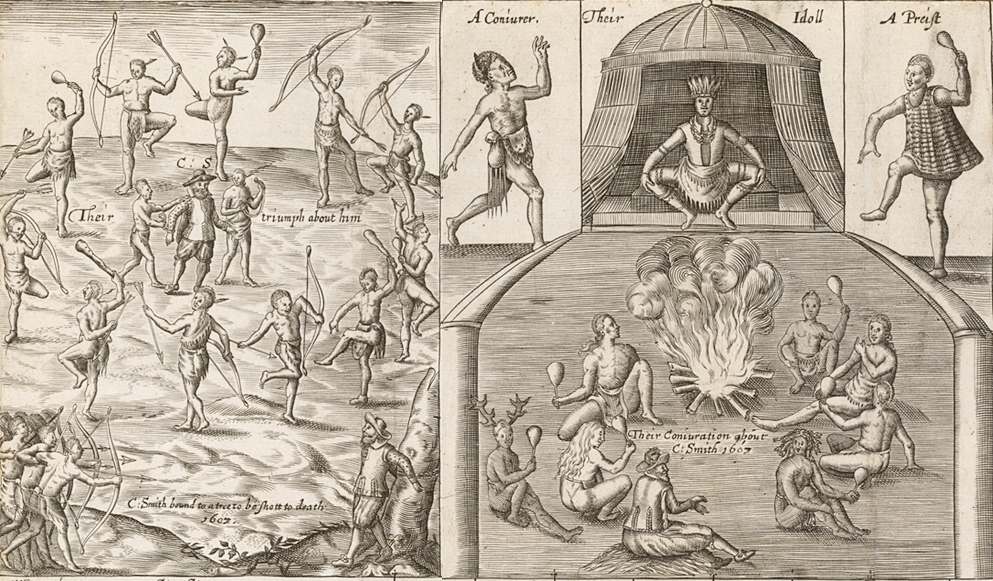

You may have noticed that these Native American / Indians look very White / European, with European facial features and physique – as well as fair shorter hair and light skin. You may have also noticed that some of them are very big – tall and muscular. None of these figures look like the mainstream ‘Native Americans’ that have jet black, long straight hair – and that are, in the main, slight / skinny, short figures.
Surely the Native Americans could not have been White people of various sizes! Maybe it was just John Smith and this engraver William Hole that messed up? Maybe the artist mis-interpreted John Smith’s sketches and descriptions…. or maybe not. Let’s investigate and look at other publications and depictions.
Here is an official photo of what the Powhatan supposedly looked like. See the tall European gentlemen on the the right. A very strange feel to this photo – a posed and unnatural photo. You will see various photos of so-called Native Americans dressed up in the 1800s, and they are nearly all are posed and feel unnatural (I have provided a gallery below for you). These Powhatan in the image below are very small and look nothing like the sketches above. Their dress is also very different.
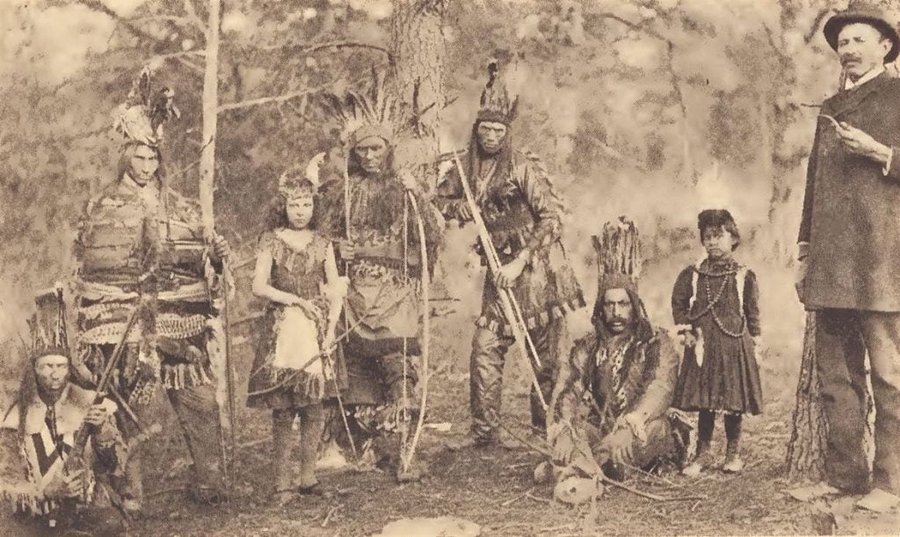
Below is a selection of photographs of the the so called North American Native Americans taken in the 1800s. These are absolutely a fair reflection of the photos you can find. Look for yourself. You will see numerous very posed photographs. These small, dark, fairly delicate looking people are the Native Americans we were told all these explorers encountered in North America. There are images of the so called ‘natives’ of the West Indies and South America in later parts of this article. (Thumbnails click to enlarge):
In the above gallery there is another particularly strange photo where we can see some White people looking out of a window from behind the ‘Indians’ being photographed… again, it all seems very staged and contrived.
Theodor De Bry’s ‘Grand Voyages – Early Expeditions to the New World‘
“Theodor De Bry is best known for his wonderful series of volumes chronicling many of the earliest expeditions to the Americas. De Bry, a Frankfurt goldsmith, engraver, print-seller and book-seller, started the project in 1590 when he reissued Thomas Hariot’s narration of the first English settlement in “Virginia.” This volume, to which De Bry added illustrations, was a success and it was followed the next year by a similar volume on the first French attempt at colonizing Florida. From then until his death in 1598, De Bry published other illustrated volumes and the series was continued until 1634 by his family, extending to 25 parts and including voyages to Asia as well as the Americas.
Each volume of the De Bry series was accompanied by graphic illustrations of the events, many made from first hand observations. These very rare prints are some of the earliest authentic images of the New World, for previous accounts either contained no illustrations or their images were crude and mostly imaginary. Thus, De Bry’s prints provide an important contemporary view of the history of the nascent days of European conquest and settlement in America. The pictures show detailed scenes of native customs, culture and warfare, and episodes in the history of European contact with these natives and their world. As Michael Alexander said, De Bry’s work “brought to the European public the first realistic visualization of the exotic world opened up across the Atlantic by the explorers, conquerors and settlers.” http://philaprintshop.net/debry.html
We will look at the first four parts / publications of The Grand Voyages – and some of the images they present to us, as well as accounts from Amerigo Vespucci and the related images:
The first part is Thomas Hariot’s account of his voyage to Virginia. Hariot was a surveyor on Sir Walter Raleigh’s 1585 expedition. The second part is an account by René Goulaine de Laudonnière relating French explorations in the Carolinas and Florida. Laudonnière governed two French colonies in the New World at different times (He is shown in the Images of La Moyne). The third part is an account by Hans Staden and relates his experiences in Brazil in 1547. Staden was a German who was captured by Natives in Brazil and held for nine months before escaping to a ship bound for Dieppe. The fourth section covers the work of Girolamo Benzoni – from “Historia del Mondo Nuovo” which was first published in 1565. Benzoni describes Columbus’ voyage and his own experience travelling in the New World. The fifth account is from Amerigo Vespucci – on his explorations of South America, including the Amazon River.
Sir Walter Raleigh’s Expedition (Thomas Harriot’s account) – Virginia – North America

The ‘John White’ watercolour subversion / lies:
Before we can look though all the numerous images, from a wide variety of artists and publication, we must deal with the John White watercolour subversion that is related to this expedition.
Below is a selection of black and white images / engravings that accompany this book / account by Thomas Harriot. Most are by De Bry, but some are by a G Veen. There is some controversy surrounding these images and this account – as a book was published in 1984 claiming it was presenting some recently discovered ‘John White watercolours’. Watercolours that were said to be created by John White on Raleigh’s expedition, which De Bry supposedly copied. We are told by the people connected to these newly discovered images that De Bry copied these watercolour paintings and distorted the images on purpose to make them look more Caucasian / White, as well as supposedly adding his own details to the images. This is an absurd claim. De Bry was a renowned engraver and artist, his work was used in many publications – he was very well respected. He also created many portraits of well-known figures of that time. These people are alleging that he altered these images to make his books more marketable and desirable to the European market! Would images of very different, much shorter, skinnier, dark-skinned, more exotic looking people living in America not be more sensational?
The idea that John White – who was installed as governor on one of these expeditions – created these watercolours and never had them published, and that no one had even seen them until the late 20th century (around 400 years later), is very far-fetched. They just suddenly turned up in 1984. We know the agendas of TPTB. Regardless, you will clearly see it is subversion by the end of this post, as I show you publication after publication, and artist after artist, that depict the Native Americans as tall White people in the 16th, 17th and 18th century. The images of dark-skinned ‘red Indians’ did not start to appear until sometime in the 19th century.
And as mentioned, the images in the publication are also not only by De Bry, as another engraver created some of the illustrations. We don’t know exactly whose descriptions or sketches these two artists were using to create the images for the publication. In later examples, in this post, you will see that explorers can sometimes create basic engravings / sketches while they are in the field / on location, or when they had returned to Europe. It is highly likely that the images De Bry and G Veen created were based on Thomas Harriot’s descriptions, and perhaps by some other people who were on the expedition. Some sketches may have been provided by members of the expedition as well, as this is what occurred in other expeditions I researched.
Examples of De Bry’s and G Veen’s engravings are below. Hopefully you have read my article on Ancient Giants (Part 1) – in it we look at old paintings and see how the giants – tall humans over 7 foot tall – were being depicted in them. We saw how they had a different build, and that you could tell if the paintings were of giants, by the robust chunky babies / toddlers – and especially by the women’s different build. These women below also have the same build. Bigger arms, broader shoulders, thicker legs – and breasts that are rounder, as well as smaller in relative size to the body:
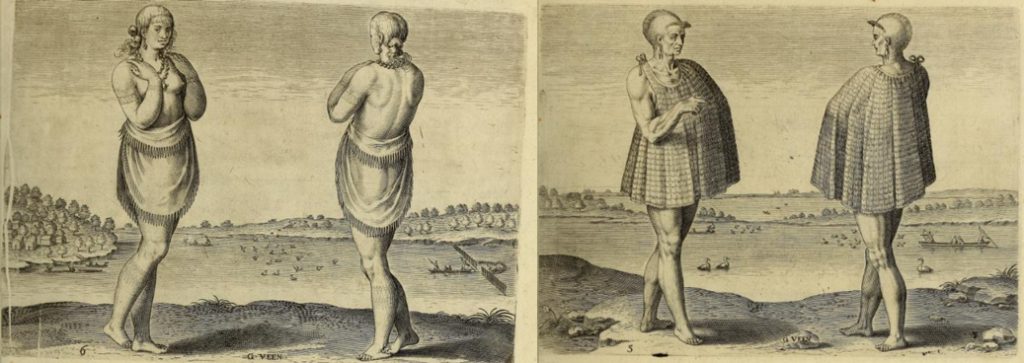
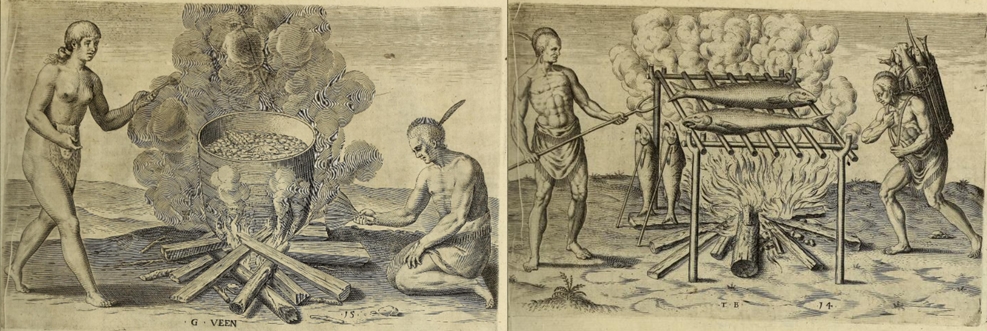
Below are some comparisons between De Bry’s images from around 1590, and the subversive watercolours published in 1984, that are said to be what De Bry copied and altered on purpose.
The John White Subversion:
The first five engravings are by De Bry – the watercolours attached on the right were supposedly by John White:
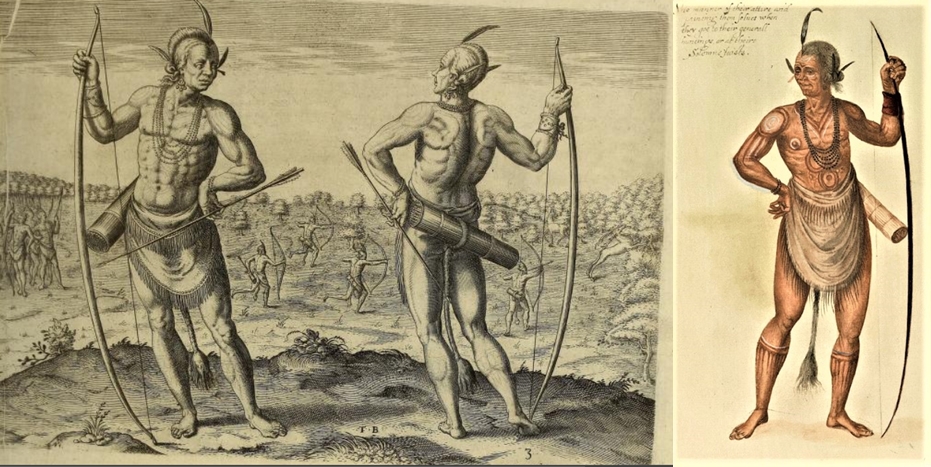
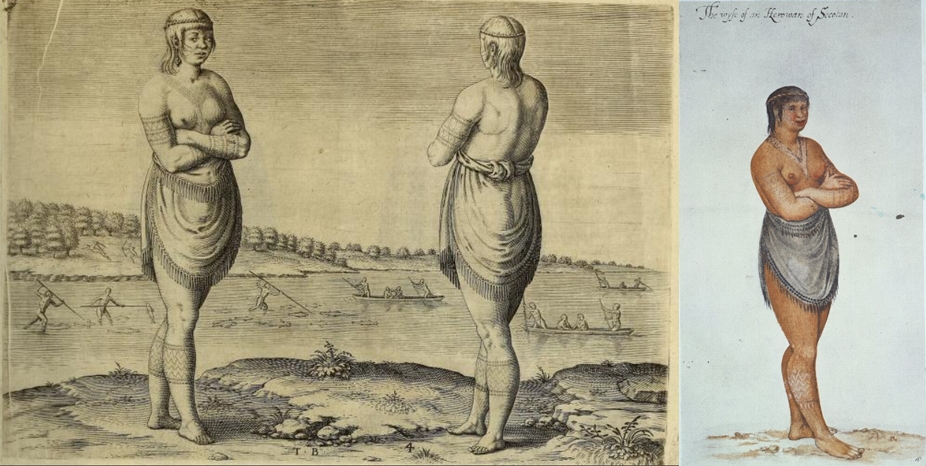


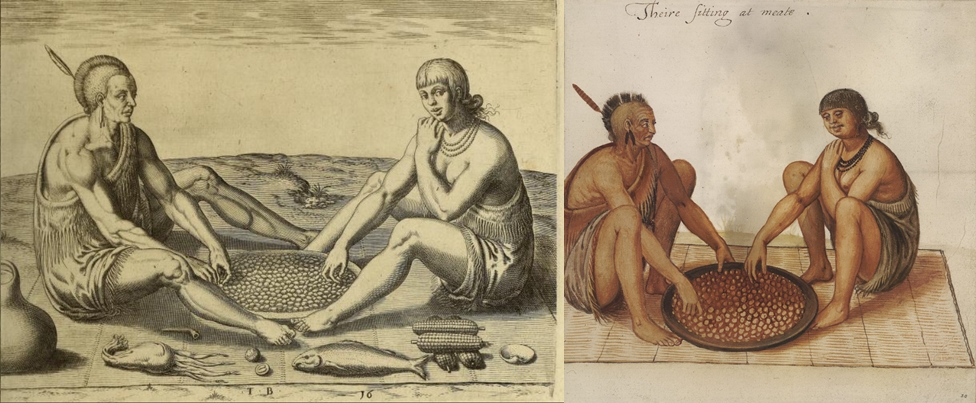
You can see in these ‘John White watercolours’, on the right, that they have tried to fake the aging of the paper. Two images do look fairly yellow, the others still have bright paper with blotches added. The yellow paper of De Bry’s images show the genuine aging of paper that is over 400 years old. Some of these ‘John White watercolours’ look fresh, and definitely not 400 years old.
This engraving below was not actually created by De Bry, but by another artist: G Veen.
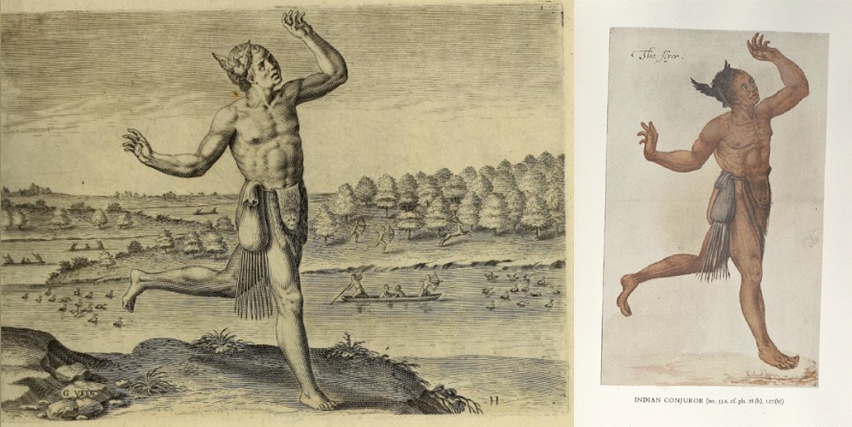
To suggest a very well-respected artist / illustrator would change these watercolours is ridiculous, and insulting to our intelligence. We can also see the La Moyne watercolour image that De Bry copied – in the following section of this article – and it was incredibly accurate. Though many will fall for this subversion, as they do not do the necessary due diligence.
Was John White even an artist? Did he create any water-colours? There is no information about John White before the expeditions and after them – very little known about him, other than some of his activities on the expeditions. When you take note of some of the testimonies of his activities in the Americas, on these expeditions, you see that he was installed as governor in one location and had responsibilities. John White was given the task of establishing a colony in Raleigh ‘s charter territory – it does not sound like he was sent on these expeditions as an artist. And where is the rest of John White’s artwork if he was an artist? I can only find the images of these Indians, and some of the wildlife there. It is his only artwork.
These faked water colours could not manipulate, and hide, the size of these people and their physiques. These are not skinny, wiry, roughly 5 foot 5 inch ‘Red Indian’ humans. They are tall, muscular White / Caucasian humans. Have you ever seen any so-called ‘Native Americans’ that look like those people in those watercolours?
René Goulaine de Laudonnière Explorations – Florida – North America

Jaques La Moyne:
In 1586, Rene de Laudonniere’s narratives on the French experience in Florida were published. The next year, Jacques le Moyne made plans to publish his own account, accompanied by his own artwork of the expedition’s experiences in Florida. Unfortunately, Le Moyne died within that year, and so he was unable to finish the project.
A Flemish engraver, Theodore de Bry, had been in contact with Le Moyne and was interested in doing the engraving work for the publication. After Le Moyne’s passing, de Bry bought the paintings from Le Moyne’s wife and set about the engraving process.
Unfortunately it seems only one of La Moyne’s original watercolours remain. Here is it is:
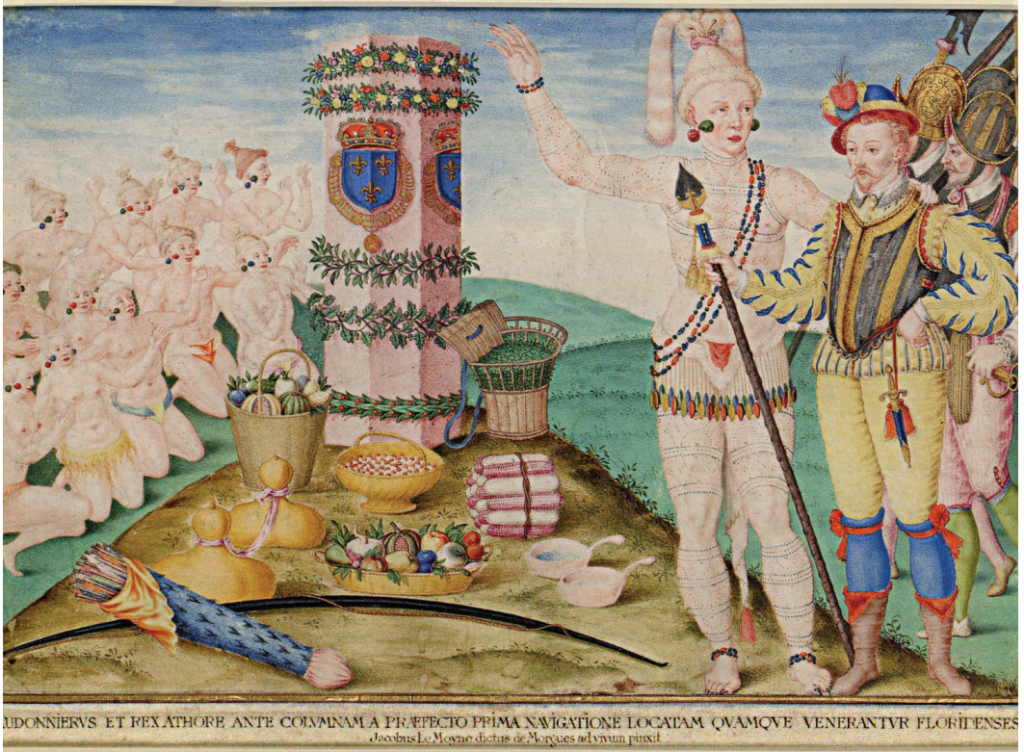
The Indian chief Athore showing René Goulaine de Laudonnière the column that was erected by Jean Ribault in the previous expedition.
Note how a few of the Indians in the background have different shades to their hair – one red and one dark brown, with the others very fair. And note the red hair of the Frenchman Laudonniere. As shown in my Medieval and Renaissances Giants article on this website, these tall red-heads dominated Europe, and ruled nearly all the nations of Europe in the 1400s, 1500s and 1600s.
Below is the copy of this above watercolour by De Bry, but more accurately we should say: a conversion of a painting into an engraving by De Bry.
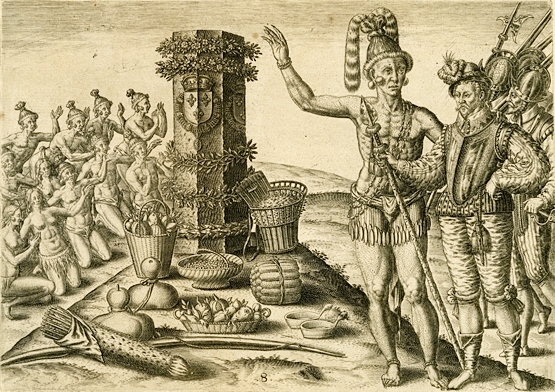
An incredibly accurate conversion of La Moyne’s original painting by De Bry. It is unusual to have such a watercolour, from a visitor to those regions, to work from – usually the artists / engravers have simple sketches and descriptions from the explorers to work with. We can see De Bry did not alter, or add, a single thing to the image, and he did not change any features of the people. So why would he do so for the first Grand Voyages book? Because he didn’t – the ‘John White watercolours’ published in 1984 were fake and a subversion.
Where did all La Moyne’s other watercolours go? De Bry created a lot of images from them. It is very suspicious. But thankfully we still have one, so we can see what these Indians looked like.
De Bry created various engravings and we can assume they were all based on La Moyne’s other watercolours (now missing watercolours). We can see very clearly that La Moyne depicted the Indians of North America as White, fair and muscular. They were tall, very robust and looked to be of substantial height… what we smaller humans might call giants.
The women in these images look like old statues of White goddesses, significant European female figures in ancient times, and women depicted in Renaissance oil paintings that documented various ancient tales.

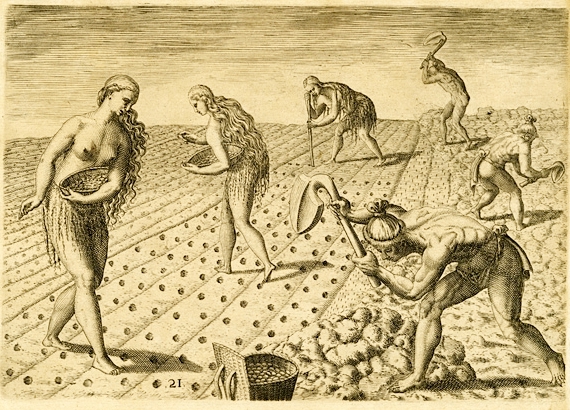

Online you can see some of De Bry’s engravings that have had coloured added to them, by other people, at a later date, often adding brown skin tones and colouring in the hair dark. These are sometimes said to be La Monye’s watercolours, but they are definitely not. They are De Bry’s engravings with colour added over the top by some unknown person. We can see this very clearly when comparing La Moyne’s original work to these hybrid pieces. There is a section later in this post that deals with this.
Hans Staden – Brazil – South America
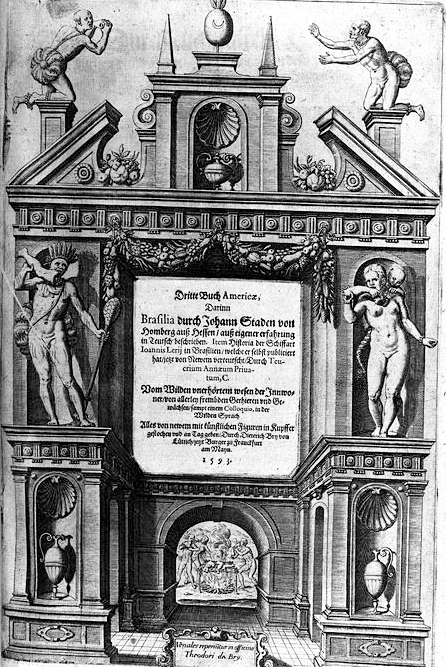
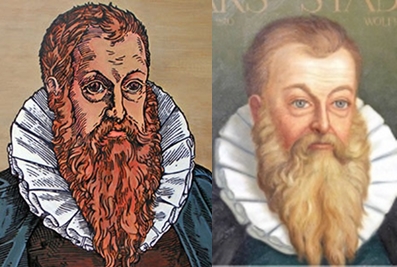
“Staden was born in Homberg in the Landgraviate of Hesse. He had received a good education and was in moderate circumstances when desire for travel led him to enlist in 1547 on a ship that was bound for Brazil. He returned from this first trip on 8 October 1548, and, going to Seville, enlisted for a second trip as a volunteer in an expedition for Río de la Plata which sailed in March 1549. On reaching the mouth of the river, two ships sank in a storm. After vainly trying to build a barque, part of the shipwrecked crew set out overland for Asunción. The rest of the crew, including Staden (a knowledgeable gunman), sailed upon the third vessel for the island of São Vicente, but were also wrecked. Staden, with a few survivors, reached the continent in 1552, where he was hired by the Portuguese thanks to his knowledge of the cannon.
A few weeks later, while engaged in a hunting expedition, Staden was captured by a party belonging to the Tupinambá people of Brazil, an enemy group of the Tupinikin people and their Portuguese allies. As Staden was part of a Portuguese crew, he was perceived of as an enemy of the Tupinamba and they carried him to their village (the predecessor of today’s Ubatuba) where he claimed he was to be devoured at the next festivity. However, Staden allegedly won the favor of the Tupinamba Chief Cunhambebe by translating between the Tupinamba and European traders as well as predicting a Tupinikin attack on the tribe, thus his life was spared. Furthermore, when Staden later claimed to have cured the tribal king and his household from illness through the power of prayer and Christianity, the Tupinamba embraced him and called him “Scheraeire”, meaning “Son, do not let me die”. The Portuguese tried several times to negotiate for Staden’s ransom, but the Indians declined all overtures. At last he made his escape on a French ship, and on 22 February 1555, arrived at Honfleur, in Normandy, and from there went immediately to his native city.”- Source
The tribe Staden lived with were cannibals – they were not the only tribe in the ‘New World’ to eat other humans.
Hans Staden published his own book with his own drawings before De Bry and his family published Great Voyages books. Here are some of Staden’s images (The bearded man in the images is Staden himself):
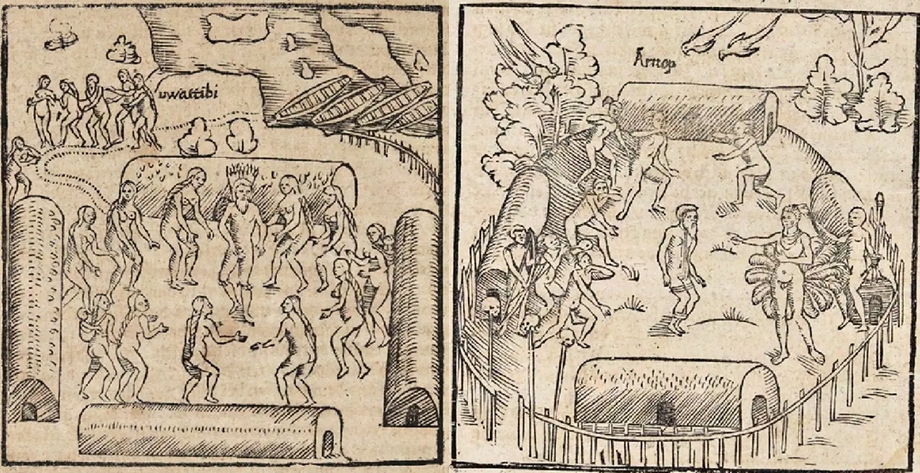
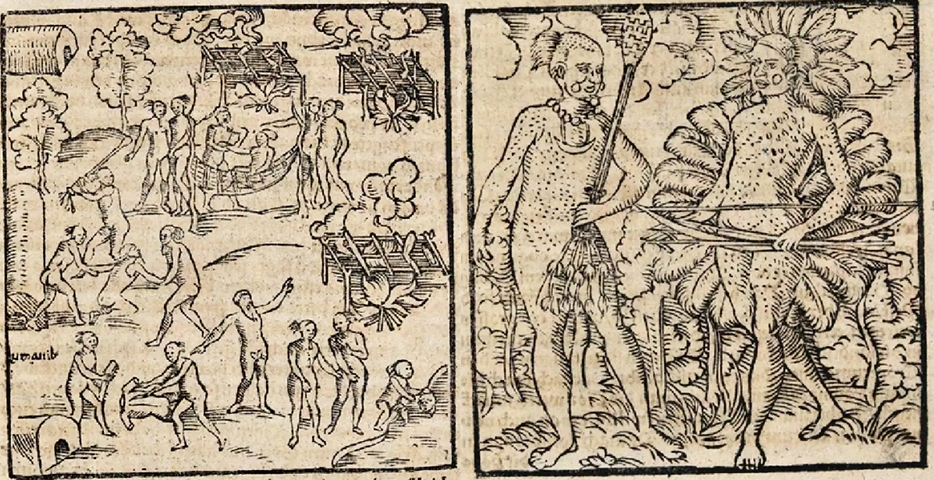

Here are some of De Brys images in his Great Voyages book:
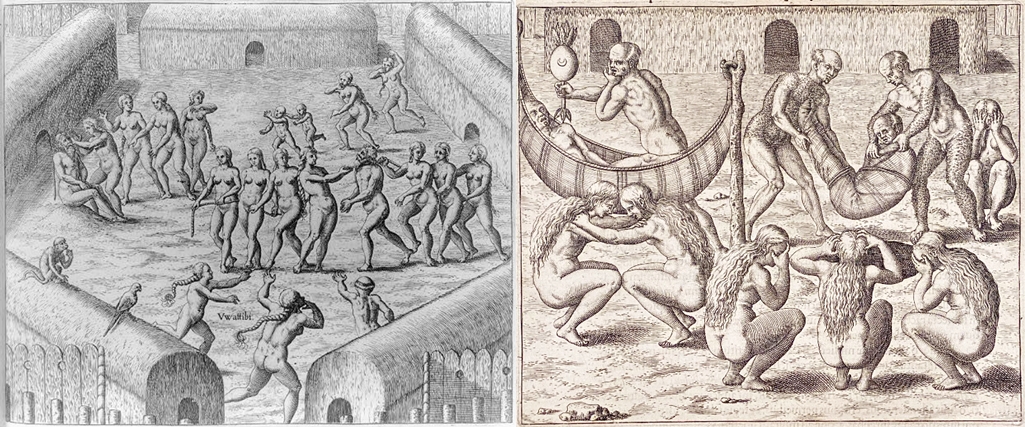
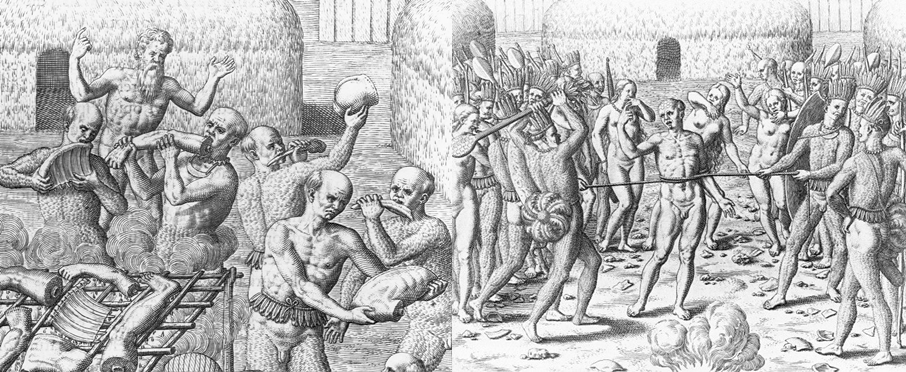

The men were not balding. They were clearly shaving their crowns. The babies and children had the same haircuts.
Girolamo Benzoni – Greater Antilles (Caribbean etc) and South America
Girolamo Benzoni (1519-1570) was an Italian Explorer from Milan who spent the years 1541-1556 in the New World. His observations of Spanish imperialism were published in 1565 in La Historia del Mondo Nuovo. Benzoni describes Columbus’ voyage and his own experience travelling in the New World. De Bry followed a Latin translation of Benzoni’s work to publish in his Grand Voyages, adding numerous engravings.
Part 4 of de Bry’s Great Voyages – the landmark compilation of travel and discovery narratives.
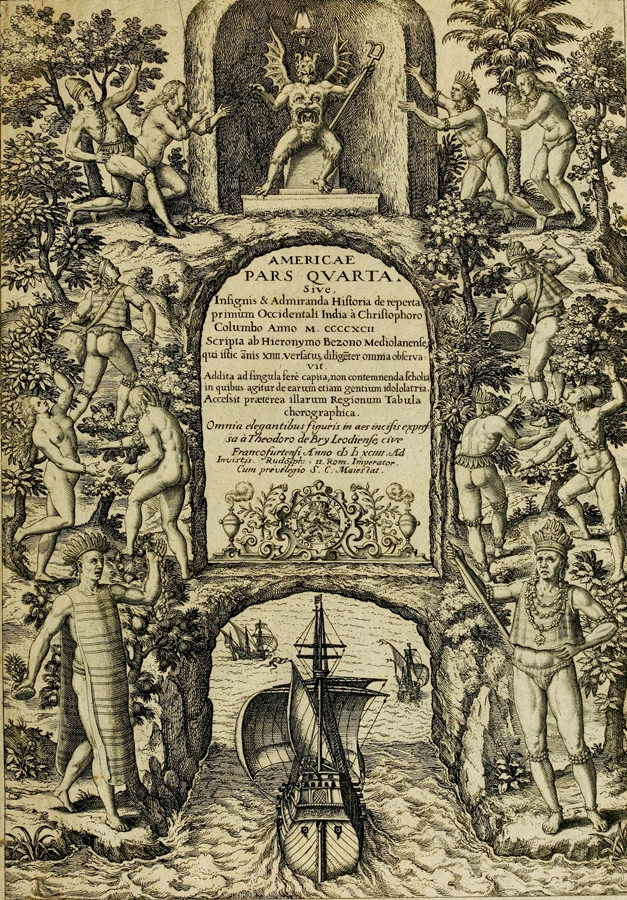
In this publication there is an image created by De Bry of the Arawak people that Columbus first met on his arrival to the New World:
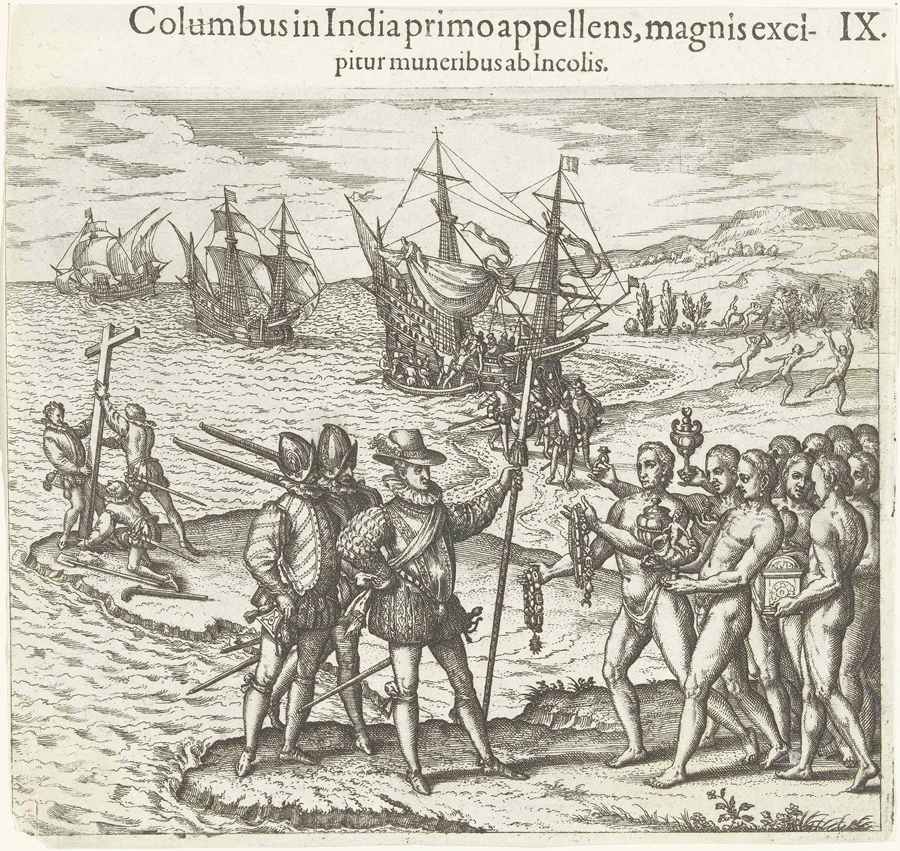
Someone on another website created this image below, suggesting how the Arawak looked more like ancient Greek sculptures. Indeed, they do:
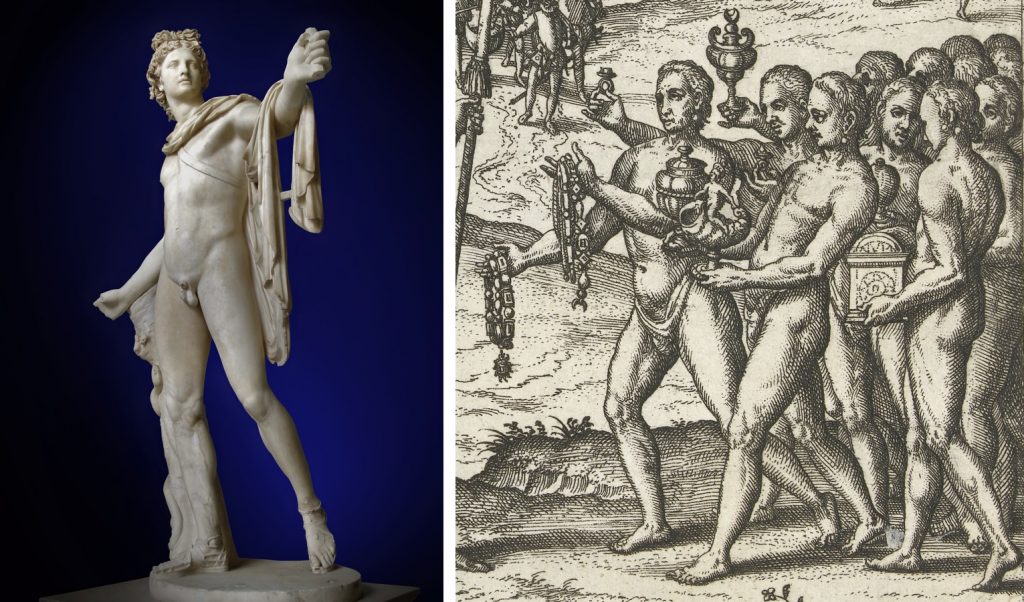
Christopher Columbus was born between 25 August and 31 October 1451, died 20 May 1506. He was an Italian explorer and navigator who completed four voyages across the Atlantic Ocean, opening the way for the widespread European exploration and colonization of the Americas. His expeditions, sponsored by the Catholic Monarchs of Spain. More on the genocide that took place by Colombus, and Catholic associates, in the Additional Information Section (Supposed genocide, in reality it was pestilence / plague that wiped tribes out – though the Spanish Catholics behaved absolutely horrifically).
A letter was sent by Columbus to the Catholic Monarchs dated February 15, 1493. It is the first known document announcing the results of his first voyage. The letter was printed and published by various people not long after it arrived. Below are the images created for these publications of his first meeting with the ‘Indians’ / ‘Arawaks’.
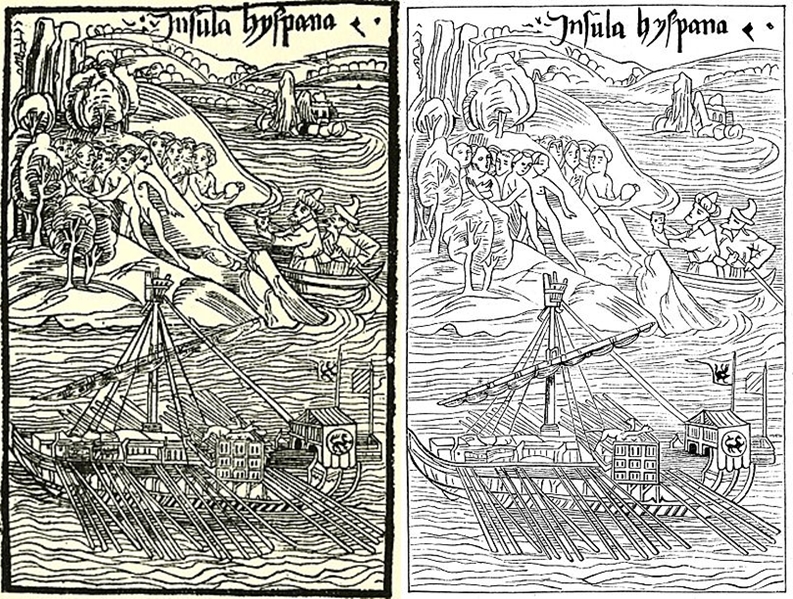
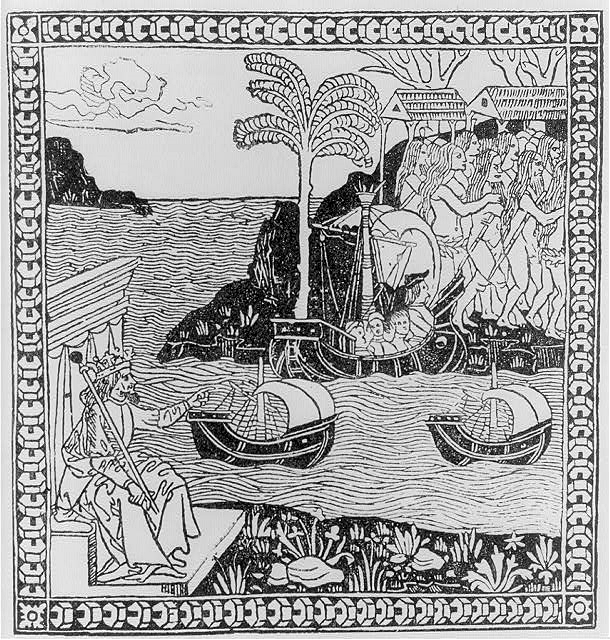
The Arawak were American Indians of the Greater Antilles and South America.
The Taino, an Arawak subgroup, were the first native peoples encountered by Christopher Columbus on Hispaniola.
(The Greater Antilles are a grouping of the larger islands in the Caribbean Sea, including Cuba, Hispaniola, Puerto Rico, Jamaica, and the Cayman Islands.)
It is important to look at what we are told (by The Powers That Be) these Arawak people looked like. The official story:
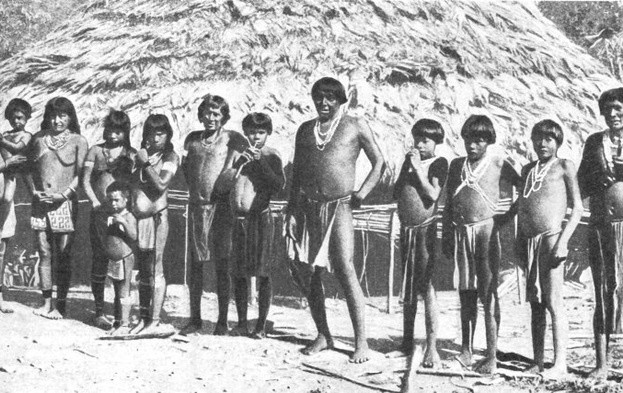


These people photographed are very small and skinny people with dark skin, just barely over 5 foot, some look shorter than 5 foot. These are the people said to inhabit most of the Caribbean Islands and South America at the time of all these voyages and expeditions. They would have looked very small next to Columbus – who was a very tall man, as were his men. Columbus even writes in his letter that the ‘Indians’ he encountered were not dark skinned. If we listen to the mainstream rhetoric, these people above are the types of people these explorers of this region should be interacting with, observing and drawing.
Girolama Benzoni published his own book on his travels in the New World before De Bry published his. Girolama’s book contained more simple or basic illustrations – a few of them are in the Additional Information section at the end of this article (They show Peruvian people that look more European).
Here are some images by De Bry’s publication, that were used to illustrate Girolama’s descriptions. These people below are different tribe to the one we see with Columbus. These people would also be classed as Arawak Indians though. Girolama went to various locations in South America and the West Indies / Caribbean:

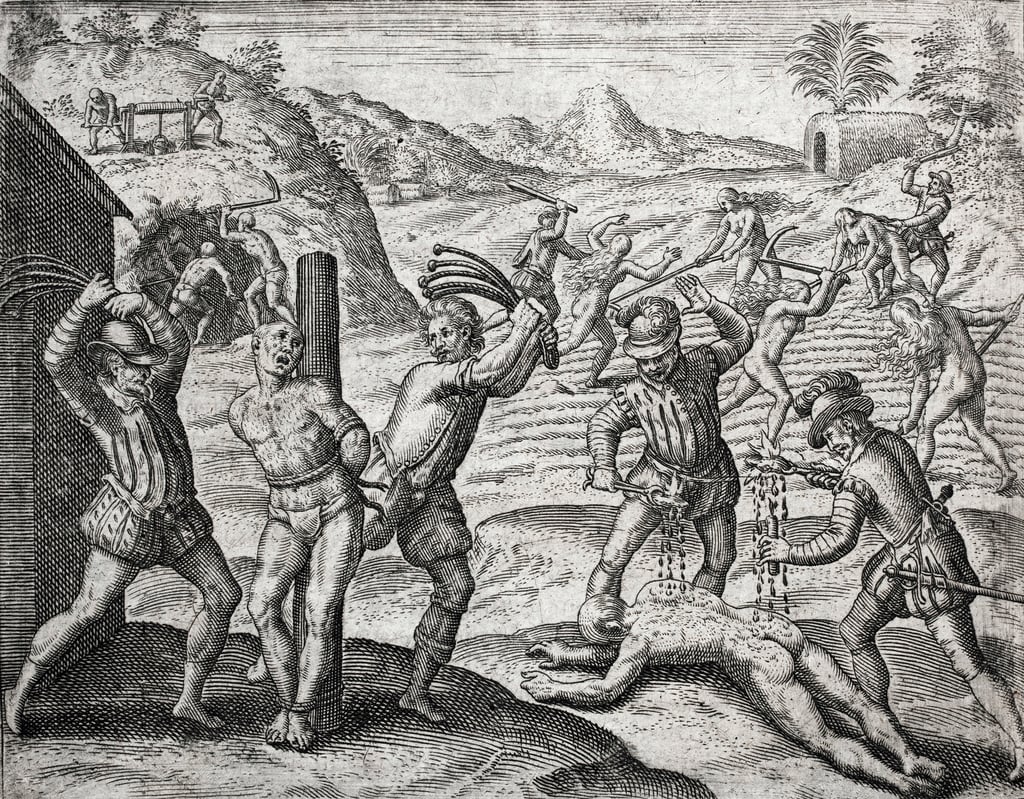
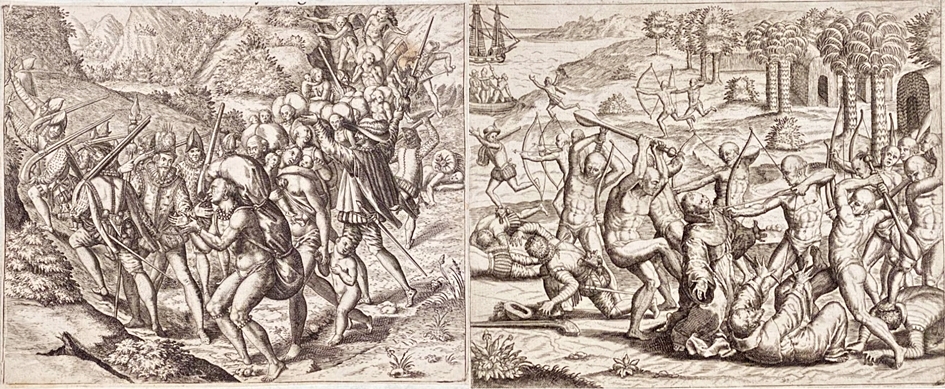
Image Below: A cropped image of a battle in Jamaica between Christopher Columbus and Francisco Poraz, showing some of the Native Americans leaving the Island:
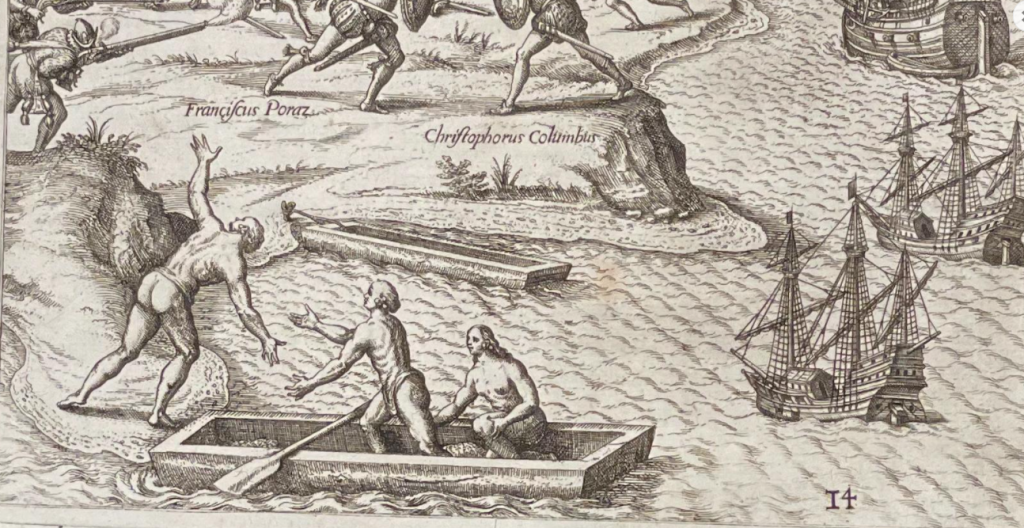
Girolama’s books show a lot of the brutality of the Spanish Christians – their brutality was very extreme, more extreme than you see above.
The Friar Bartolome de Las Casas’s also produced a book called ‘A Short Account of the Destruction of the Indies‘, which also documented the brutality committed by Colombus and the Spanish – on which I have some more information in the Additional Information section. It wasn’t small dark people that were killed by these people. It was tall, White humans. Note: Their trips / expeditions were sponsored / funded by the influential Catholics in Spain.
I have many more images by De Bry – from a variety of locations showing different tribes – which featured as illustrations in his Grand Voyages series. I will display them in the Additional Information section at the end of the article.
Amerigo Vespucci – South America (Including local Islands and Amazon River)
Between 1497 and 1504, Vespucci participated in at least two voyages of the Age of Discovery, first on behalf of Spain (1499–1500) and then for Portugal (1501–1502). His first expedition reached the mouth of the Amazon River and explored the coast of South America. In 1503 and 1505, two booklets were published under his name.
Vespucci claimed to have understood, back in 1501 during his Portuguese expedition, that Brazil was part of a continent new to Europeans, which he called the New World. Martin Waldseemüller recognized Vespucci’s accomplishments in 1507 and applied the Latinized form “America” for the first time to a map showing the New World. Other cartographers followed suit, and by 1532 the name America was permanently affixed to the newly discovered continents (I have also seen other people suggest that America was not named after this man… it is not of high importance, either way).
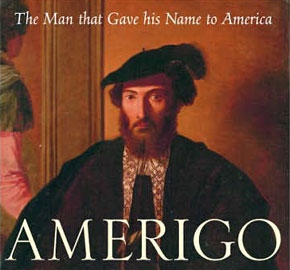
Two images from his first publications:
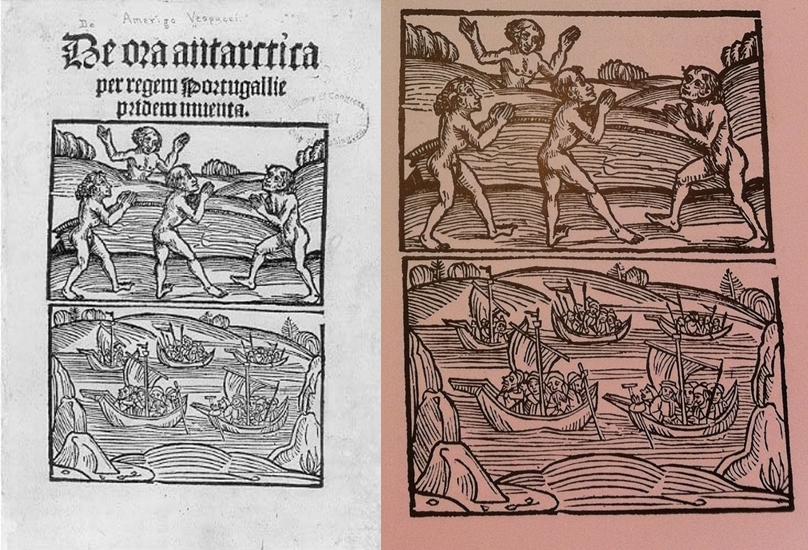
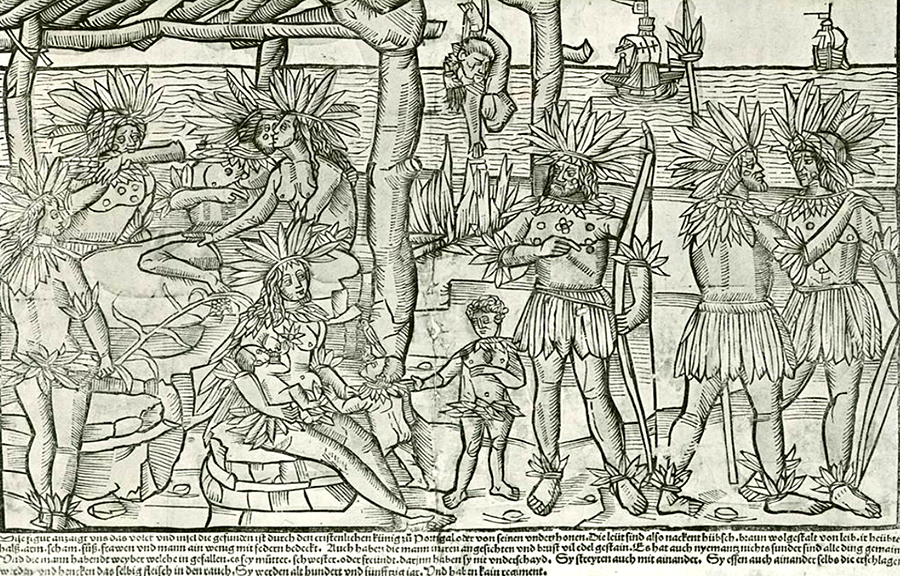
Two images from later publications of his work:

One of the more famous parts of Vespucci’s journeys was discovering an Island of Giants on Curacao (Trinidad and Tobago).
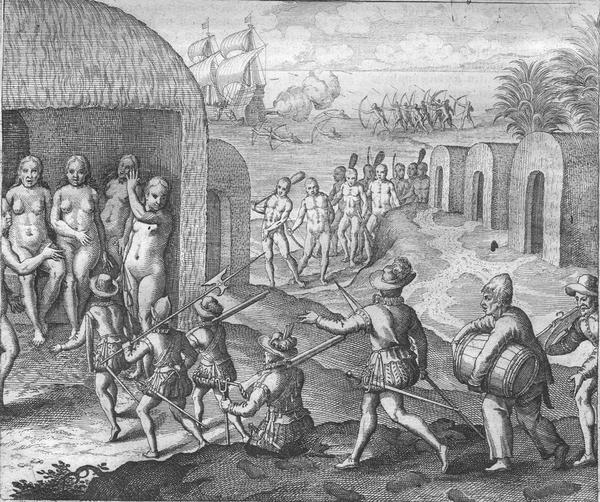
Where did all these tall muscular White humans go? Well, the Spanish Catholics wiped out some of them. But there was also another force assisting with this genocide, which is shown in later parts of this series… plague / pestilence played a big part.
Behaviour:
Before I show you many more artists depicting the Native ‘New World’ Americans as White / Caucasians I will briefly look at the behaviour and culture of these New World Indians and compare them to the current so called ‘Native Americans’.
It is important to note that we do not need to just look at the images and depictions of the American Indians in the 16th to 19th centuries to know that these people were not the same people as the current small, skinny, dark so-called Native Americans. We can look at behaviour as well. Their behaviour is described, as well as shown in the images, in all the ‘Great Voyages’ books. Obviously, the various isolated White Tribes developed different cultures and ways of existing, but none of them lived and behaved in same way as the small, dark, so-called Native Americans.
The White Native Americans in the 1500s and 1600s were often farmers. They built wooden houses and wooden fences. They even built wooden huts to smoke their meat. The below images are of North American Indian tribes:

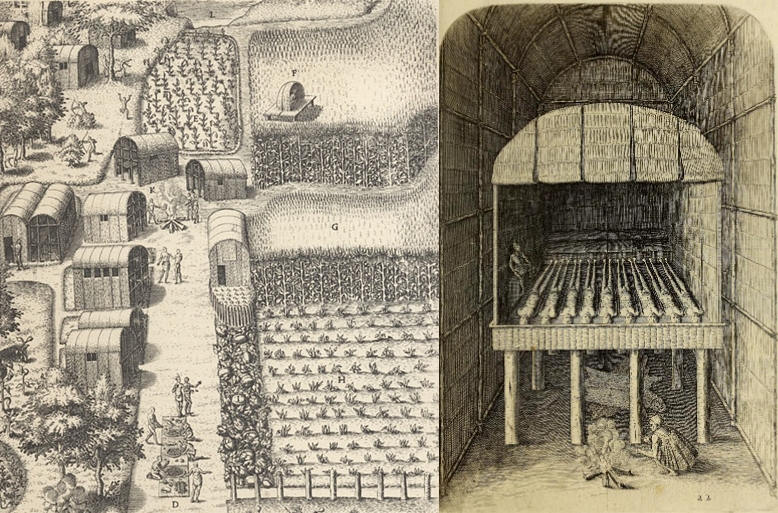
They had unusual ceremonies – different types of wedding ceremonies for example – and the leaders were usually taller humans (The giant / taller humans were at the top of the hierarchy and the leaders)

As we discovered above, some of the Indian tribes on mainland America practised cannibalism. The small, dark, so-called Native Americans did not and do not.
Many of the tall White Indian tribes also had strong predilection towards nudity. The small, dark so-called ‘Native Americans’ do not have this predilection, it is not in their culture.
We can also see other behaviours from them, such as playing certain sports and games, and some unusual inventive hunting techniques. For example, placing a dead deer over the top of their head and torso while crawling. They would also hunt animals like alligators using stakes.
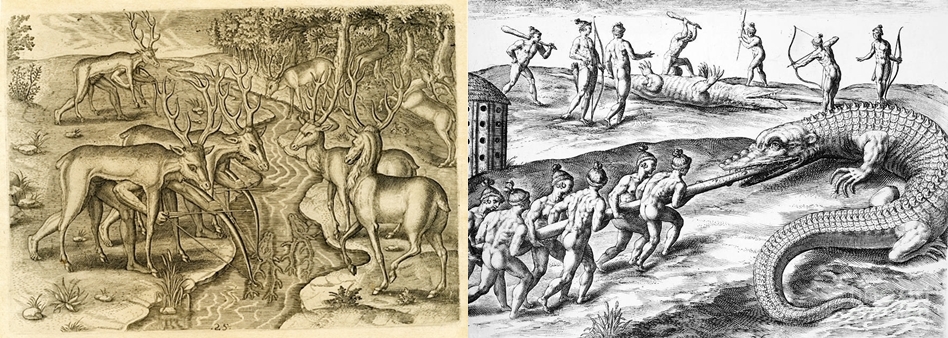
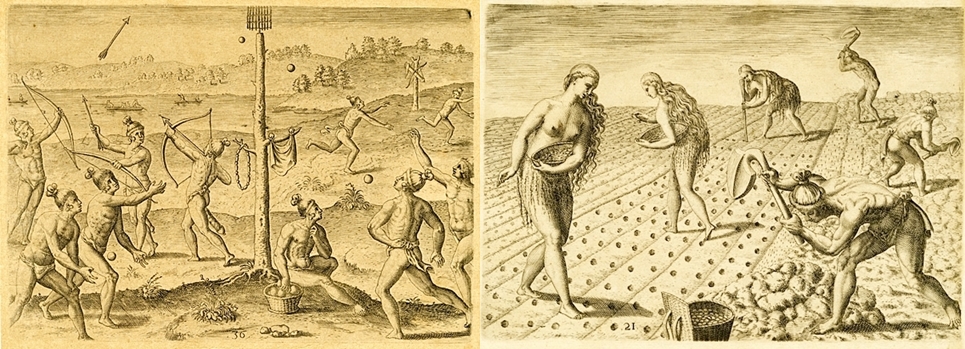
And what do we not see from the people encountered?
We do not see the use of horses, the hunting of buffalo, the use of wigwams and nomadic lifestyles. The short, dark so-called ‘Native Americans’ behave very differently.
The people encountered in these New World voyages were not these small, dark so-called ‘Native Americans’ that ‘The Powers That Be’ promote as being native to the Americas.
Before we move onto all the numerous other images, by a wide variety of other artists, we should deal with the De Bry engravings that have had colour added to them.
De Bry engravings coloured:
You will sometimes see one of the De Brys books with coloured images. You can see the colour images actually within the book – and not just as some random image with colour. It looks like an official coloured publication and the colourisation looks professional. Perhaps someone rich requested / commissioned some colourised publications, we don’t know. As well as this, online we can see some De Bry’s engravings that have been more crudely coloured and do not seem to be a part of publication. It looks like someone has taken an individual image and has added colour to. We will compare these types of colourisations now:
Coloured images in a De Bry book / publication:
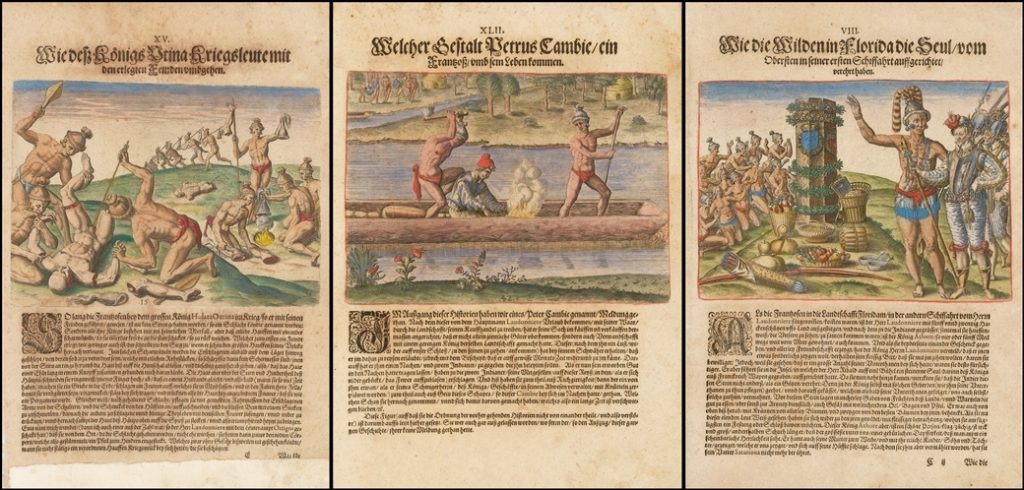
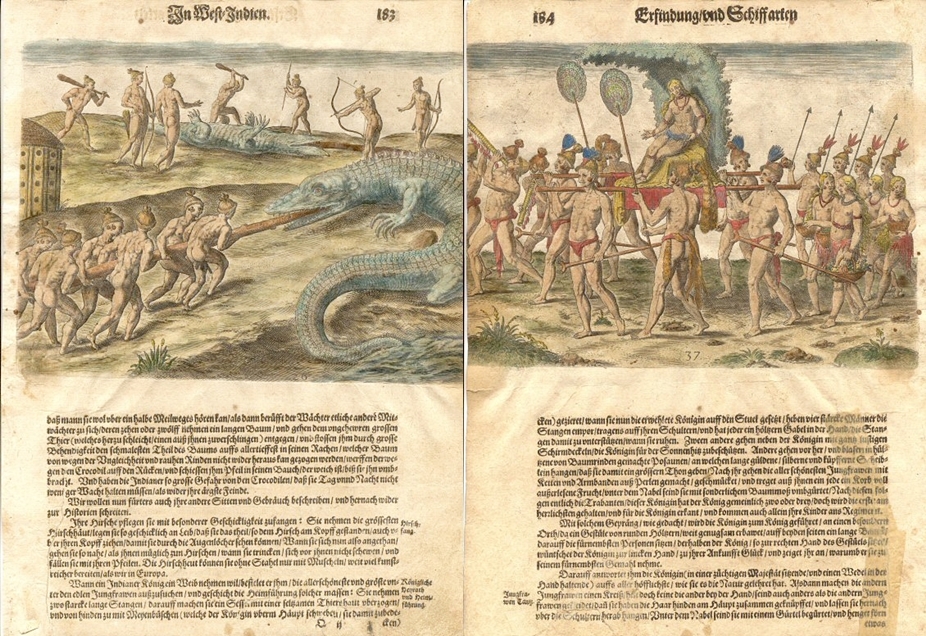
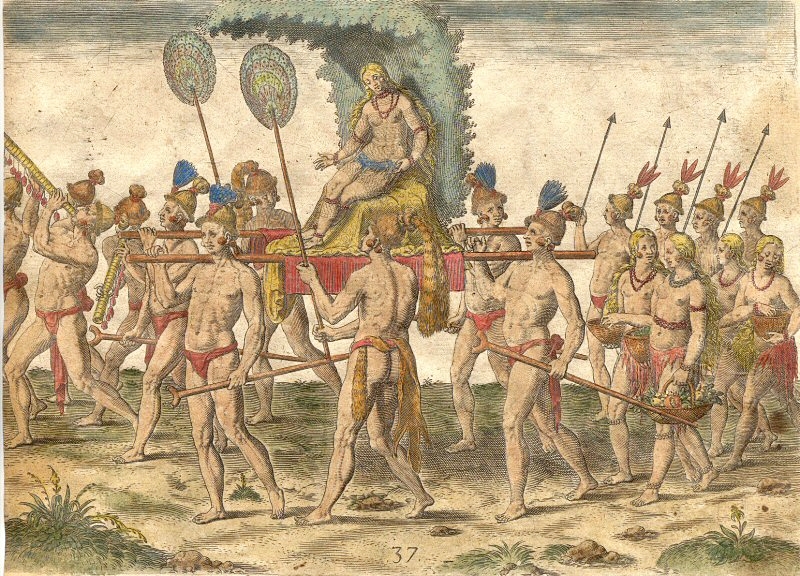
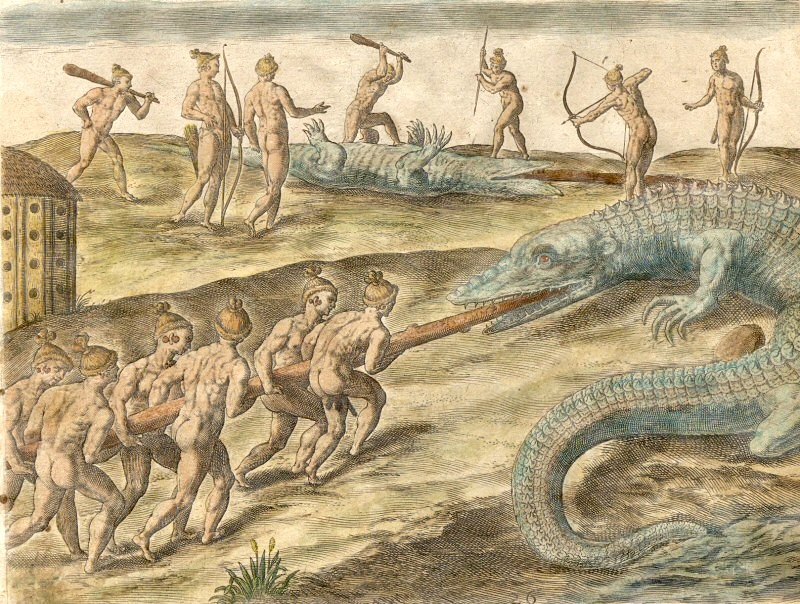
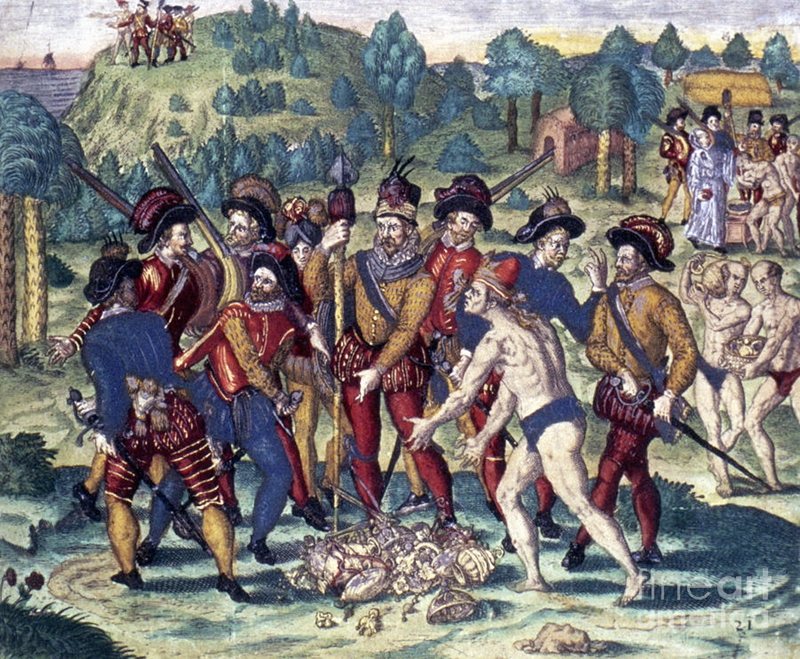
Image above: You can see that the Spanish New World Explorers looked like the European Upper Classes of the medieval period / Middle Ages – with pale skin and light brown / fair hair. They are a very tall people and not the same as the smaller, darker people that now inhabit Spain. This depiction shows an American Indian dumping gold in front of them, in anger at Spanish greed and lust for gold. An engraving by De Bry.
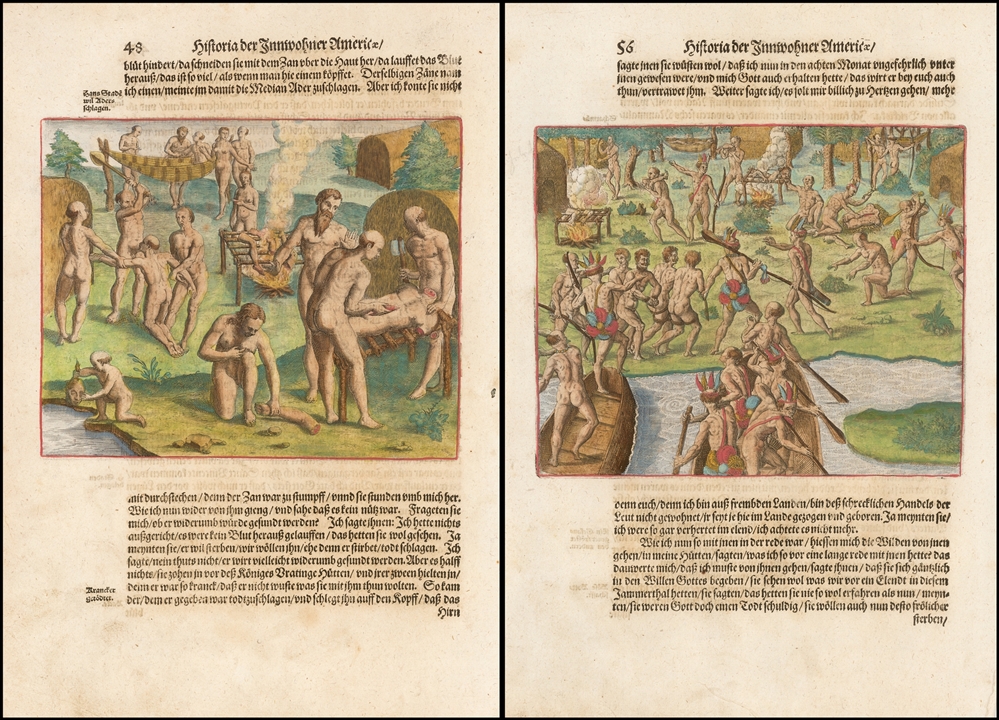
As you can see, the American Indians in the books above were coloured with light skin and with red, blonde or brown hair. Now to the other types of colourings.
Random De Bry engravings with added colour (Not coloured by De Bry or anyone associated with him):
Cruder colourings below. Some of the people who added colour made the Indians look like a multicultural tribe! Even with the darker brown skin and dark hair these people still do not look like the short, skinny, dark-skinned Indians we saw in the gallery I presented earlier, that depicted the so called official ‘Native Americans’.
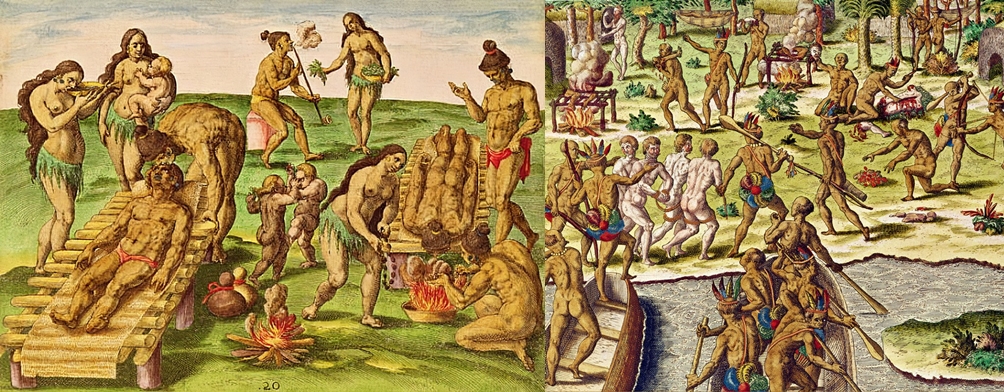
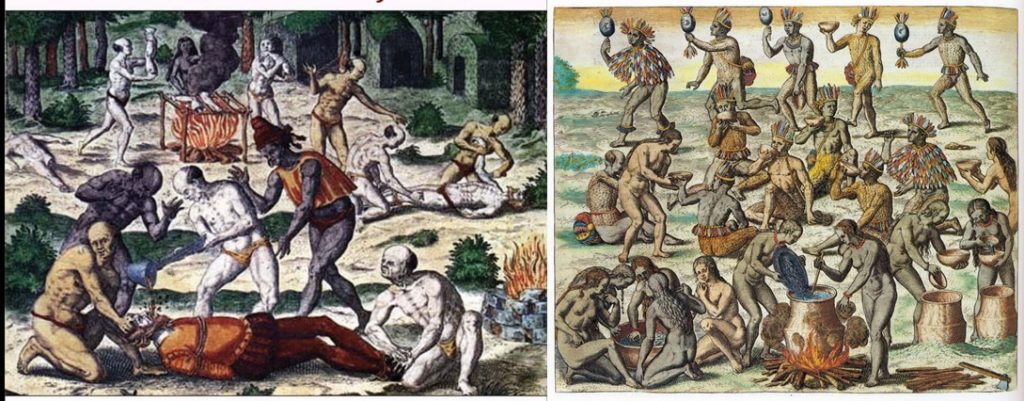
Other Artists Depictions of the Native Americans of the New World:
Simon van de Passe – Portrait of Pocahontas:
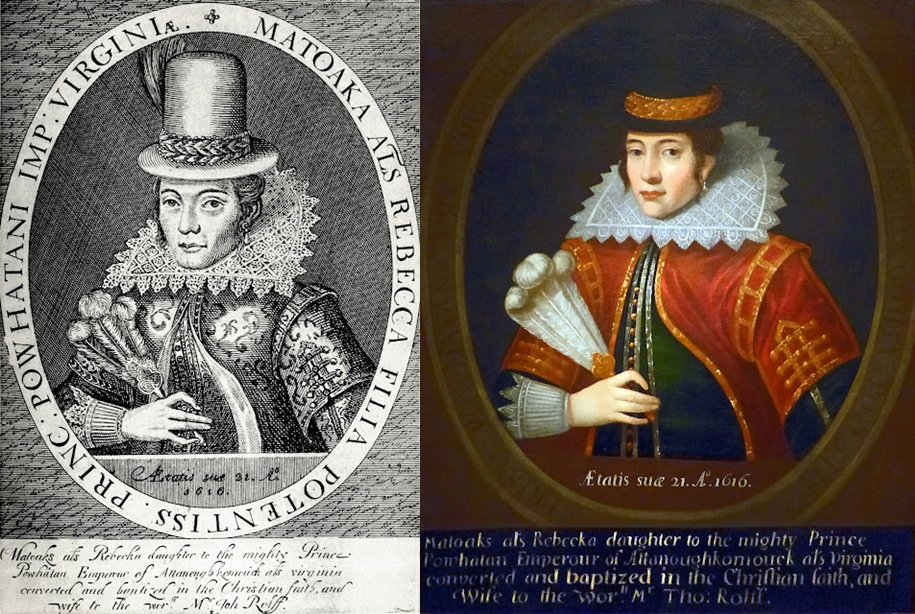
This 1616 engraving, by Simon van de Passe, on which the Booton Hall portrait is based was published in John Smith’s General History of Virginia. It is itself based on a sketch made in an actual sitting by the young artist made while Pocahontas was in England in 1616. She died, in England, in 1617. The engraving is the only surviving portrait of Pocahontas made during her lifetime. This engraving is the only known portrait of Pocahontas rendered from life. During her stay in England, Dutch engraver Simon van de Passe captured her likeness and recorded that she, like the artist himself, was 21 years old.
Wenceslas Hollar – portrait of Virginian Indian ‘Jaques’:
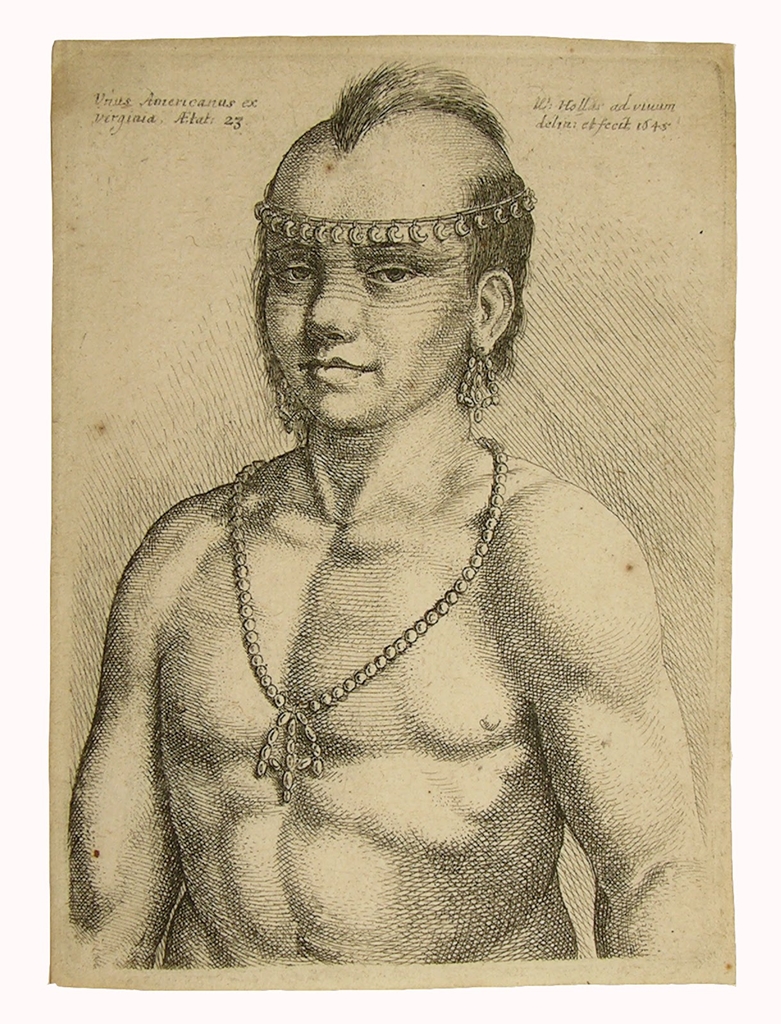
“The Indian is thought to be a certain “Jaques,” a warrior taken prisoner by colonists and subsequently given by Director Kieft to two WIC soldiers, Peter Cock and Peter Ebel. In 1644 the soldiers took Jaques to Amsterdam, where he was put on display as a curiosity… Wenceslaus Hollar, the maker of this print, will have seen the Indian in Antwerp, where he drew him from life in 1645.” http://grahamarader.blogspot.com/2012/03/offering-of-day-very-rare-and-important.html
Below is another depiction of a Native American by Wenceslas Hollar. A Virginian Native Indian.
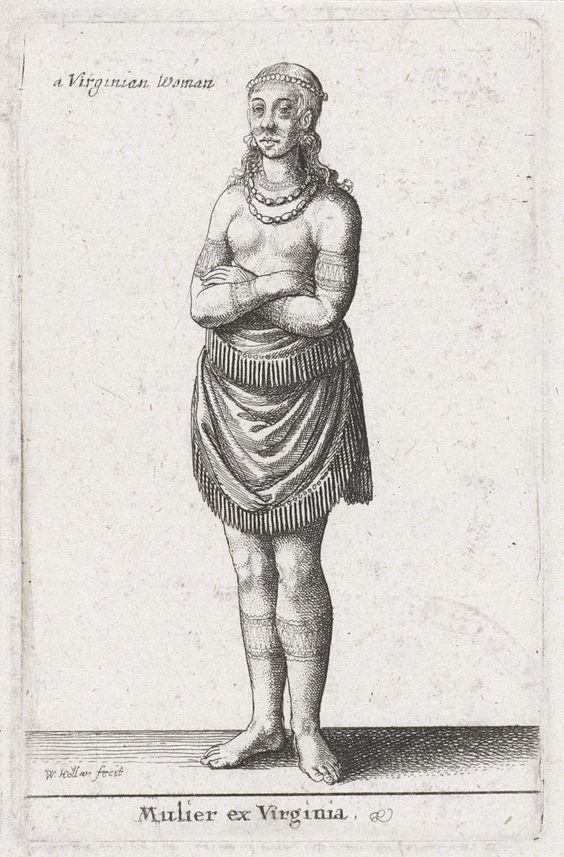
Ulrich Schmidl:
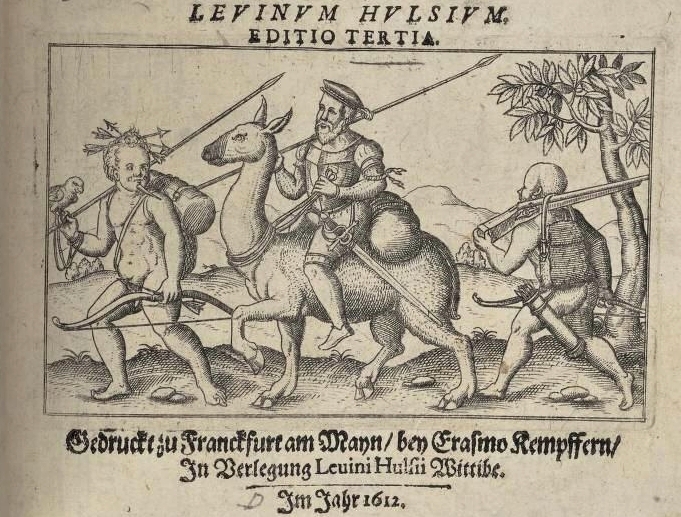
Ulrich Schmidl or Schmidel; born 1510 in Straubing; died 1579 in Regensburg; a German Landsknecht, conquistador, explorer, chronicler and councilman. Schmidl was, beside Hans Staden, one of the few the Landsknechts, who wrote his experiences down. Schmidl was the son of a wealthy merchant, and received a good education. He entered military service and took part 1534 as a Landsknecht under Pedro de Mendoza in an expedition to today’s Argentina (Río de la Plata). He also accompanied Juan de Ayolas on his first trip in quest of provisions, and afterward went with Ayolas in his expedition up Paraguay River, and was one of the soldiers that were left with Domingo Irala in charge of the vessels in the port of Candelaria. When Cabeza de Vaca was deposed in April 1544, Schmidel sustained Irala, who was the new governor, and in 1546 accompanied him in his expedition to Peru as far as the foot of the Andes, where he was despatched with Nuño de Chaves to President La Gasca. He accompanied Irala on his last unfortunate expedition of 1550. He became a founder of Buenos Aires. His journey led him across the Río Paraná and Río Paraguay and into today’s Paraguay, where he helped to found Asunción.

Samuel De Champlin:
Samuel de Champlain (August 1567 – 25 December 1635) was a French colonist, navigator, cartographer, draftsman, soldier, explorer, geographer, ethnologist, diplomat, and chronicler. He made between 21 and 29 trips across the Atlantic Ocean, and founded Quebec, and New France, on 3 July 1608. An important figure in Canadian history, Champlain created the first accurate coastal map during his explorations, and founded various colonial settlements.
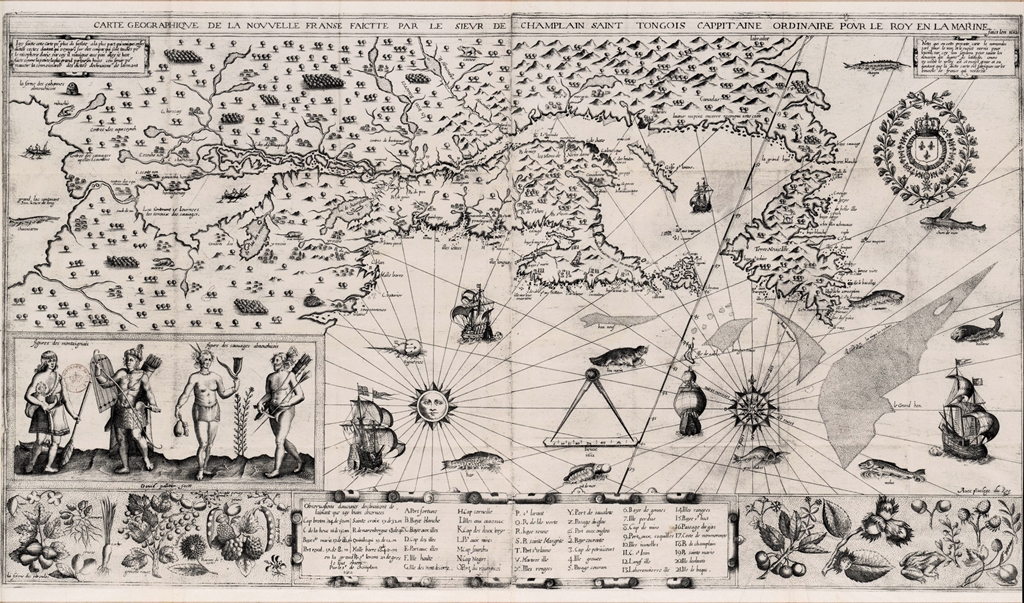

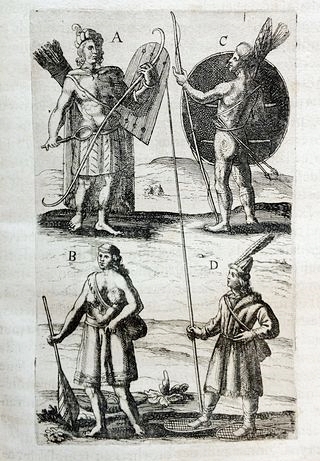
Joseph-François Lafitau:
Joseph-François Lafitau was a French missionary, ethnologist, and naturalist who worked in Canada. He is best known for his use of the comparative method in the field of scientific anthropology, the discovery of ginseng, and his writings on the Iroquois. Some images of the Native Canadians / Americans by Lafitau.

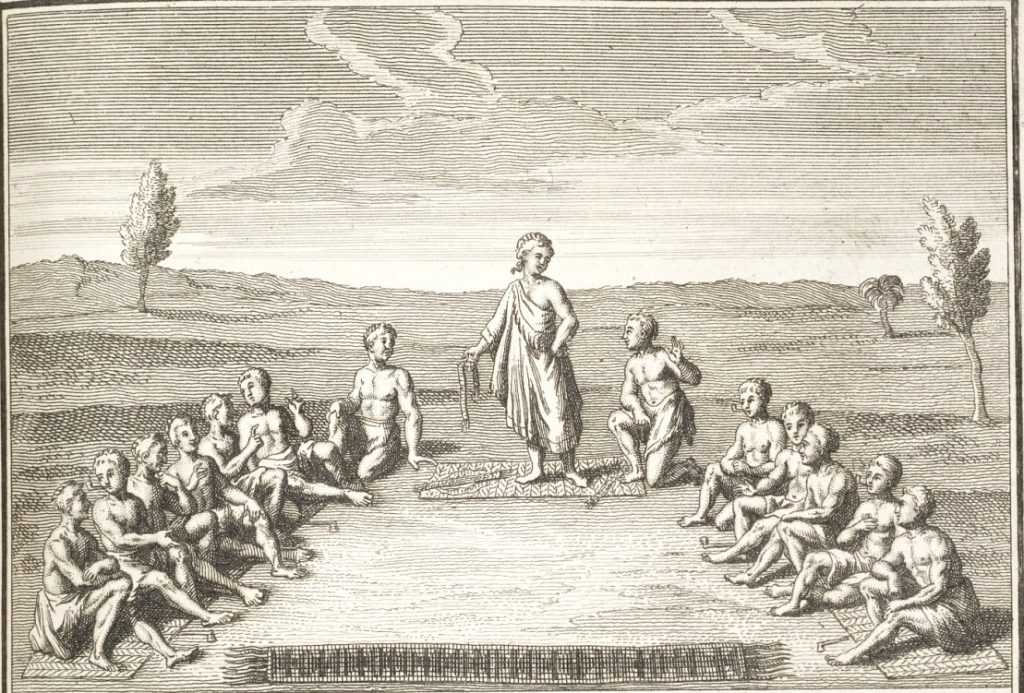
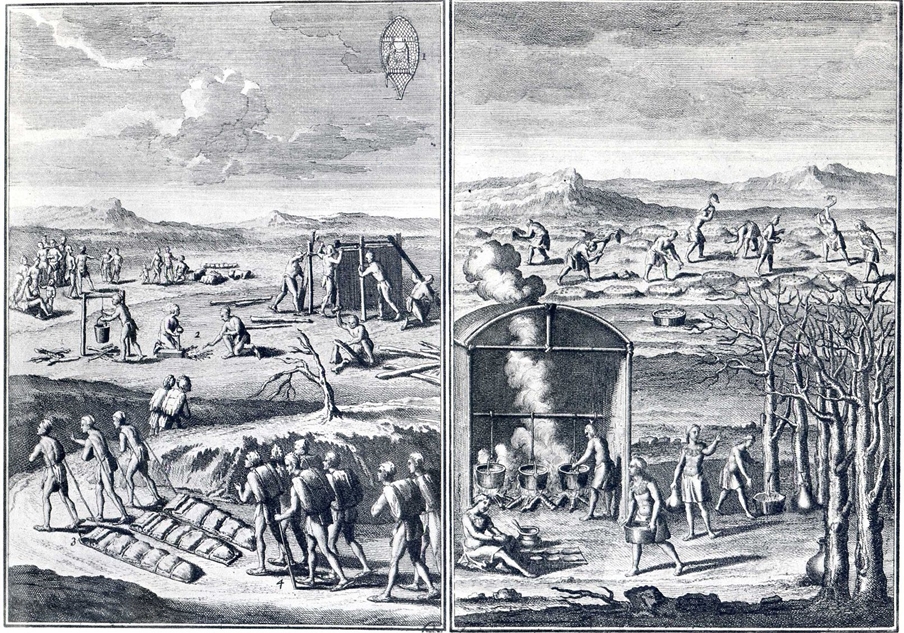
Jacques Grasset de Saint-Sauveur (1757-1810)
Depictions from the book ‘Encyclopedia of Voyages’ by Jacques Grasset de Saint-Sauveur, c. 1796
Jacques Grasset de Saint-Sauveur wrote the text and designed the engravings. The initial engravings were completed by two different engravers: Labrousse and Laroque. Here are some depictions of the Iroquois. There is also a gallery of depictions of different native people from around The New World / Americas in the Additional Information section – some very interesting images in it.
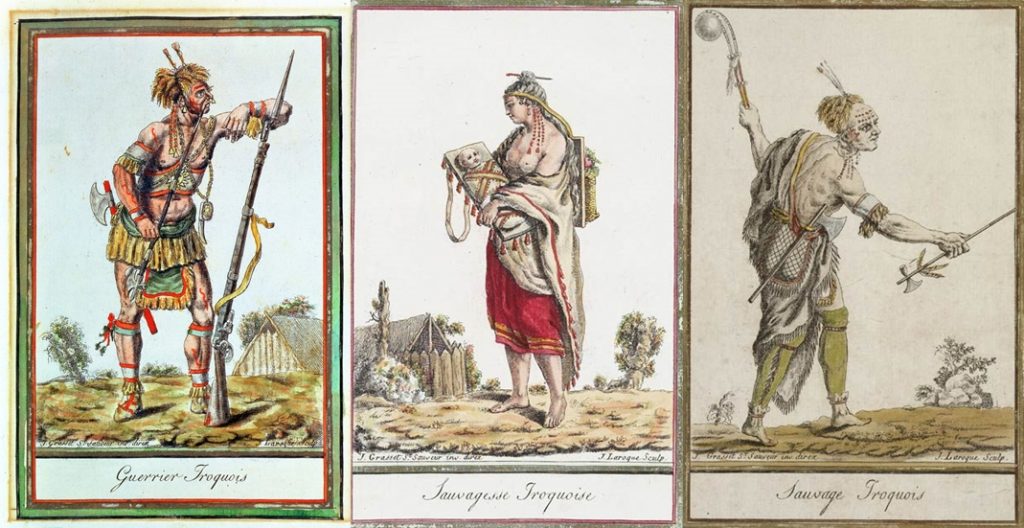
Thomas Salmon:
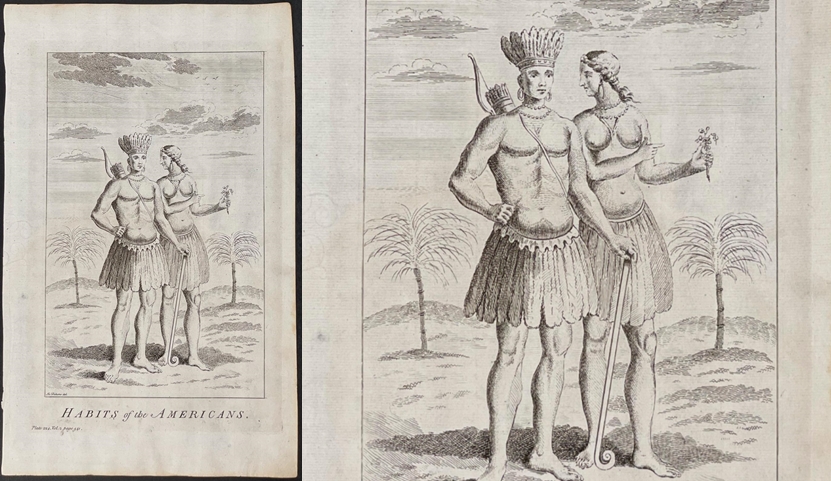
French Engraving 1700s – Artist Unknown:
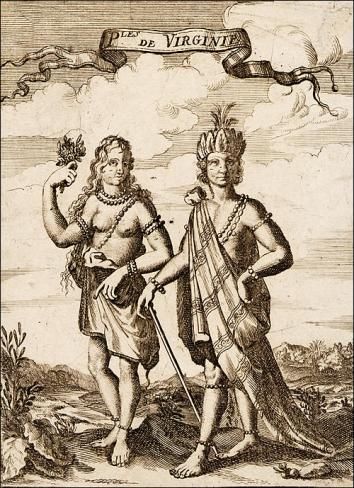
Campanius ‘new sweden’:

Patrick Gass:

Ponce De leon:
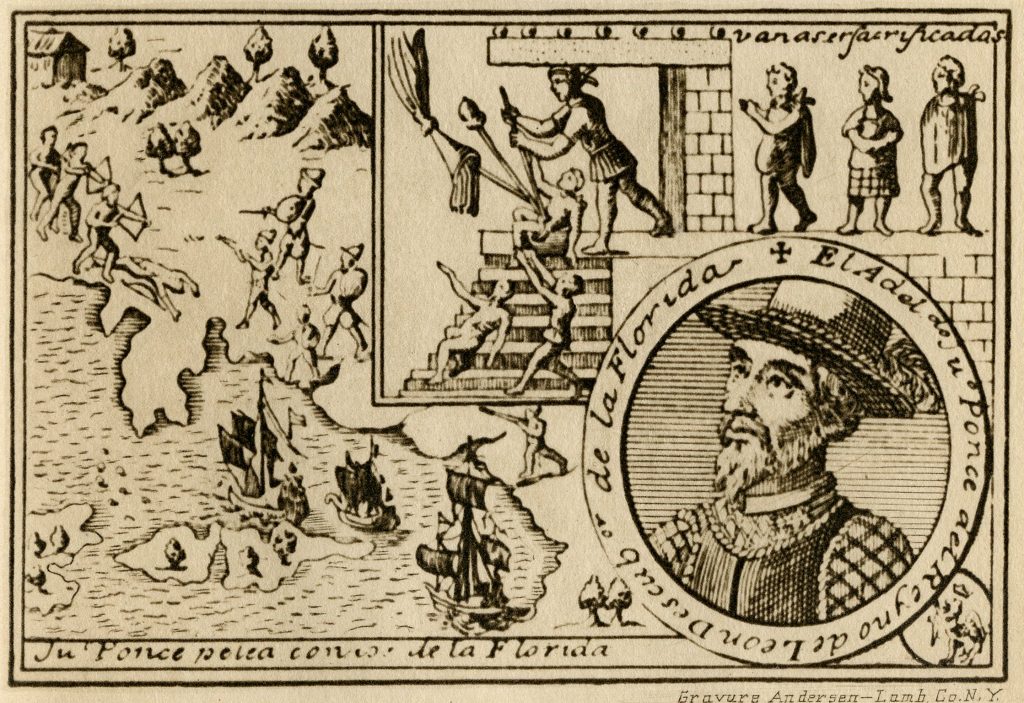
There is a fascinating story from Ponce De Leon’s expeditions. He was apparently told by the Taino (One of the tribes displayed above) that on an Island in the region there was a fountain that gave people back their youth or stopped them from ageing. I found an image / old illustration in an article about this online. It looks to be showing the large White Indians around an Old-World fountain:

This fountain would almost certainly have been a fountain from one of the surviving Old-World energy harnessing complexes – the complexes that became the sites of the World Fairs and Expositions in later centuries. This story will only make sense when you have finished the series and learnt about the energy harnessing Old World buildings / cities / complexes. Water can be infused with energy that can greatly benefit the body – I have spoken about structured and vortexed water in other articles, but the Old-World builders took it all to another level. You will see their use of water in Part 8 of this series.
From ‘Encyclopedie de voyages’ edited by Sylvain Marechal in 1788:
I believe these are also images put together by Jacques Grasset de Saint-Sauveur, using his engravers Labrousse and or Laroque. But they seem to have been created for a different publication.

Chief of the Ojibwa:
This image below is said to be Sir John Caldwell ‘dressed up’ as chief of the Ojibwa (A Canadian Native Tribe located near to Quebec). He must have really been very keen ‘to get into the character’, as he has nose and lip piercings!!! (And it looks like ear piercings as well). I looked into this Sir John Caldwell – I did some digging. There was someone in Quebec called this. But Sir John Caldwell was born in 1775. The painting is dated as 1780 (I also saw it dated as 1782). So, John was either 5 or 7 years old at the time this painting was created. And regardless, why would this man have dressed up in all this regalia, and have all these piercings done, to have an oil painting created of him? Not logical. You would just paint a picture of the actual chief. I would strongly suggest this is a painting of the actual chief of the Ojibwa.

Patagonian Giants:
Images created by Pernety based on the first-hand observations of two captains:
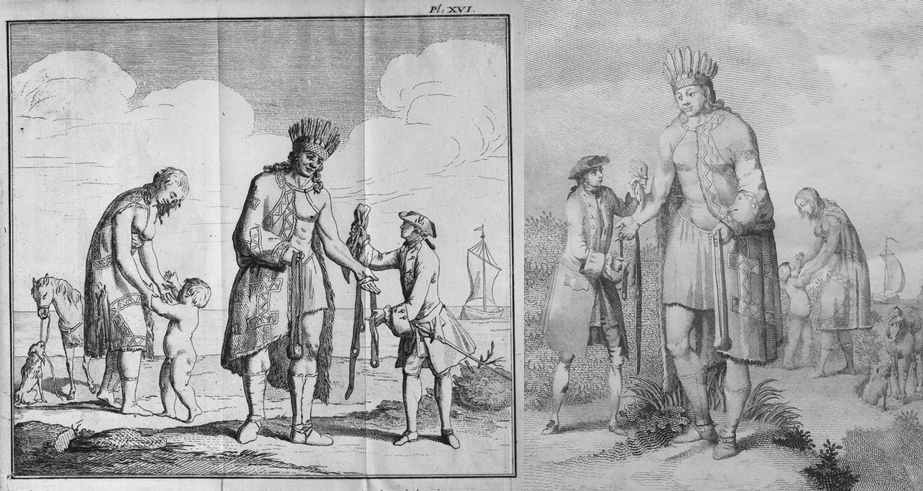
“It is no surprise that the subject caught the attention of Pernety; the controversy was probably what prompted him to the add the reports of two of Bougainville’s captains (Duclos-Guyot and Giraudais) to his own book. This was logical: both captains had recent, first-hand contact with the Patagonians, having observed them at close quarters while visiting the Magellan Strait in 1766, to collect timber for the new colony on the Falkland Islands. Nonetheless, it should be noted that at no time did Pernety meet the Aónikenk.” https://patlibros.org/frm/index.php?fun=myth&lan=eng
The World for a King: Pierre Desceliers’ Map of 1550 – commissioned by Henry the 2nd of France:
I found this map via controlled opposition YouTube channel. There was a link to this map in the description. The map was on the ‘bl.uk/manuscripts/Viewer’ – you could zoom in very close and see some very interesting images (The world population in 1500s was very different from what we have been told). Anyway, you can no longer view this map and zoom in – it is no longer accessible on the website. But I took some screengrabs when I first saw it, so I have some close ups. Below are two cropped images from South America:
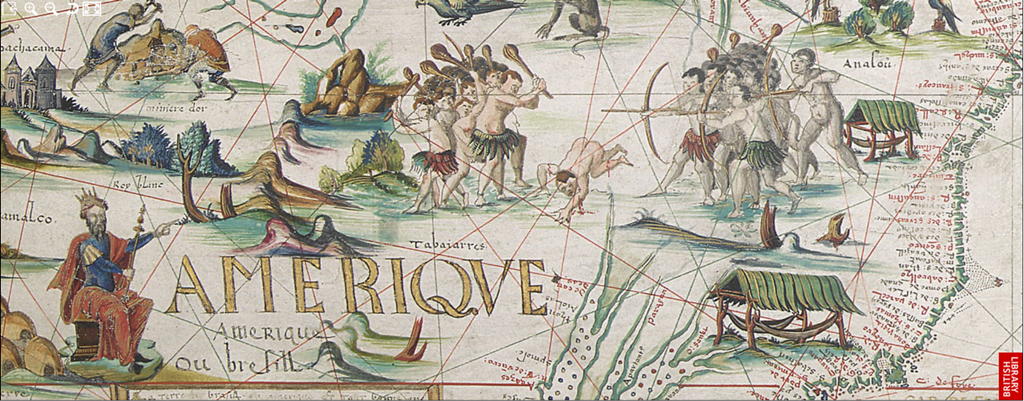
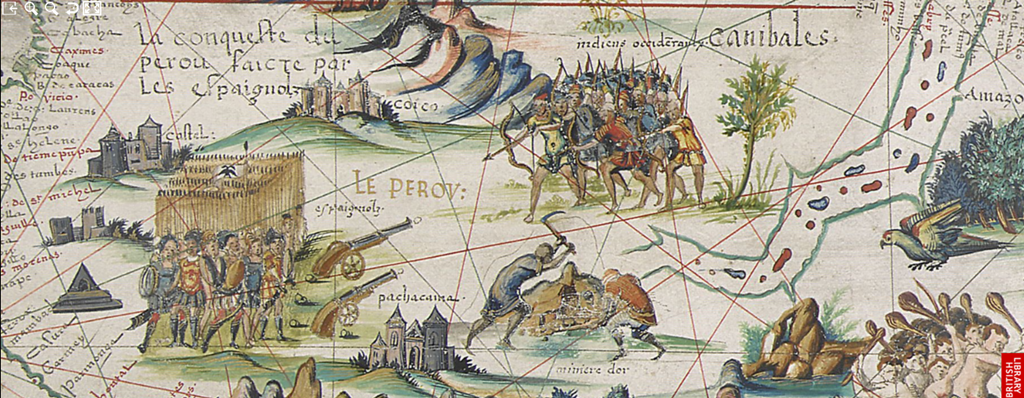
Nowhere on these Descelier maps of South and North America do you see short, skinny, dark figures with straight, black hair.
Nicolas de Larmessin:
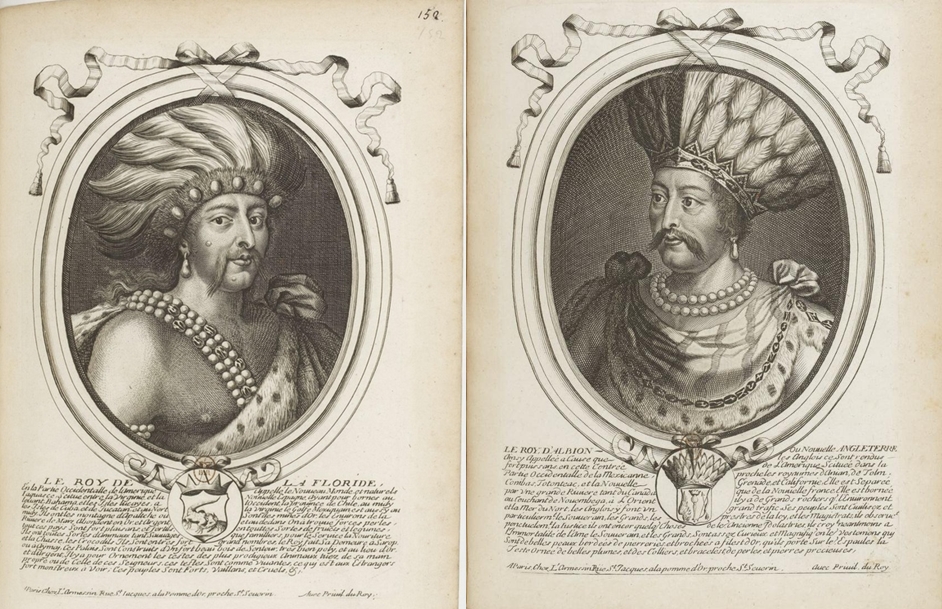
Rulers of Florida and New England in the 1600s.
These two Indian leaders above, have similar facial features as the Medieval and Renaissance European Nobility shown in Part 2 of this series. They are clearly not the so called ‘Red Indians’.
An 1800s image:
This image below was said to have been created in the late 1800s (I cannot find the name of the artist). It appears that someone did not get the memo. Some knowledge and Truth slipped through the net:
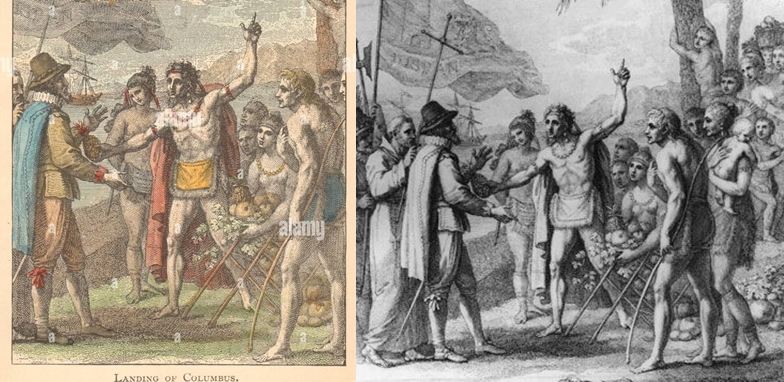
Thoughts:
Some of you may be in shock. The Americas were totally dominated by White people. White people of various sizes: From 5-foot plus Caucasian humans to, what looks like, some Caucasian humans that were around 12 or 13-feet-tall (The Patagonian Giants and the Giants on Curacao). The most prevalent seemed to to be the 7 to 8 feet-tall humans.
In my research I saw no images, or mention of, short, dark people in these regions from before the 19th century.
There were perhaps some darker people living with the Aztecs – as there were some people who were coloured in dark in some of the cartoon like images in some old Aztec codices. I am not sure who they were and what ethnicity they were. I am also not sure if they were coloured in at a later date. I would like to know the Truth about that. But other than that possible sighting in one region of Mexico I have seen no depictions of short, skinny dark people with straight, black hair from the 1500s, 1600s and 1700s illustrations of the Indians of the Americas.
You probably have many questions. They should be answered in the following articles in this series. If they are not, ask me in the comments section and I will try to help.
If you come across any interesting information, or useful resources, related to this topic, when you do your own research, please share it in the comments section.
We are not finished yet though, there is more information and plenty more images below.
Additional Information and Galleries
- Laudonniere
- Columbus
- Dominican Friar Bartolomé de Las Casas
- Other locations
- Aztecs (Mexicans)
- Incas (Peruvians)
- Dutch Expeditions to South America (Guiana, Tierra Del Feugo)
- Johann Ludwig Gottfried
- Mocha Island, Chile
- Amazonian Women
Some text and then some more images. Galleries with more images from the tribes above – and then some images from other regions / tribes.
Florida – Laudonniere on the Floridian Natives:
A testimony from Rene de Laudonniere, of the friendliness of the Floridian natives towards him:
On their second voyage to the New World, the French arrived off the coast of Florida on Thursday (June 22, 1564) around three or four o’clock in the afternoon. They landed about thirty leagues south of the St. Johns River. In his own words, Captain Laudonniere states:
“Having reconnoitered the river, I landed to talk to the Indians who waited for us on the bank. They cried out with a loud voice in their native language ‘Antipola bonnassou,” which means ‘brother,’ ‘friend,’ or something like that. After they had made much of us, they introduced their paraousti, or king or chief, to whom I presented certain trinkets. This pleased him immensely. For my part, I praised God without ceasing for the great affection that I found among these savages. They were unhappy at nothing except that the night approached which would take us away. Though they endeavored by every means to make us trade with them and explained by signs that they wanted to give us some presents, nevertheless for various good reasons I decided not to stay.” – Three Voyages, Rene Laudonniere
Columbus and the Indians he encountered in the Indies:
(Relayed in his letter to the Catholic Spanish Monarch The Catholic Monarchs that he was working for)
“Columbus characterizes the native inhabitants of the Indies islands as primitive, innocent, without reason (“like beasts”, “como bestias”), and unthreatening. He describes how they go about largely naked, that they lack iron and weapons, and are by nature fearful and timid (“son asi temerosos sin remedio”), even “excessively cowardly” (“en demasiado grado cobardes”).
According to Columbus, when persuaded to interact, the natives are quite generous and naïve, willing to exchange significant amounts of valuable gold and cotton for useless glass trinkets, broken crockery, and even shoelace tips (“cabos de agugetas”). In the printed editions (albeit not in the Copiador version) Columbus notes that he tried to prevent his own sailors from exploiting the Indians’ naïveté, and that he even gave away things of value, like cloth, to the natives as gifts, in order to make them well-disposed “so that they might be made Christians and incline full of love and service towards Our Highnesses and all the Castilian nation”
Columbus makes particular note that the natives lack organized religion, not even idolatry (“no conocian ninguna seta nin idolatria”). He claims the natives believed the Spaniards and their ships had “come down from heaven” (“que yo…venia del cielo”). Columbus notes that the natives of different islands seem to all speak the same language (the Arawaks of the region all spoke Taíno), which he conjectures will facilitate “conversion to the holy religion of Christ, to which in truth, as far as I can perceive, they are very ready and favorably inclined”.
Possibly worried that his characterization might make it appear that the natives are unsuitable for useful labor, Columbus notes that the Indians are “not slow or unskilled, but of excellent and acute understanding”. He also notes that the “women appear to work more than the men”.” https://www.wikiwand.com/en/Columbus%27s_letter_on_the_first_voyage
More on Columbus (from — https://ournativeamericans.blogspot.com/2018/06/1492-christopher-columbus-vs-native.html):
When Christopher Columbus (1450-1506) came in contact with Native Americans, he wrote: “They all go around as naked as their mothers bore them; and also the women.” He also noted that “they could easily be commanded and made to work, to sow and to do whatever might be needed, to build towns and be taught to wear clothes and adopt our ways,” and, “they are the best people in the world and above all the gentlest.”
….as Columbus approached land, the local Natives, the Arawaks, swam out to greet the ships. Columbus later wrote, and “They do not bear arms, and do not know them, for I showed them a sword, they took it by the edge and cut themselves out of ignorance… They would make fine servants… With 50 men we could subjugate them all and make them do whatever we want.”
Note the Islands tribes and Mainland tribes behaved somewhat differently. The Mainland tribes were used to warfare and battles, the two tribes depicted above in the main article that were cannibals were mainland tribes. In one translation it said that all the Islands tribes, bar one, were not cannibals.
On the Spanish brutality:
Dominican Friar Bartolomé de Las Casas (1484-1566) wrote, “The Spaniards think nothing of knifing Indians by tens and twenties and of cutting slices off them to test the sharpness of their blades.” He wrote of 2 “Christians” who met up with two Arawak boys and beheaded them for fun. “Mothers drowned their babies from sheer desperation, husbands died in the mines, women died at work, children died from lack of milk… my eyes have seen acts so foreign to human nature, and now I tremble as I write,” de Las Casas lamented.
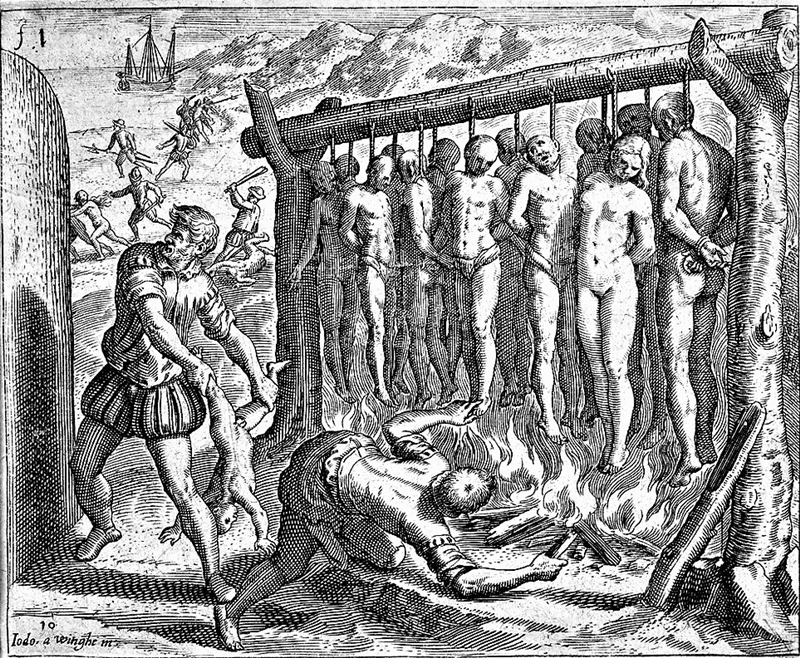
Do not think of these Spaniards as the small darker-haired people we see in Spain today. These were a significantly taller people; modern day smaller humans did not come to prominence in Europe until the late 1700s or early 1800’s. This is explained in other articles in this series.
Columbus’ Genocide:
According to Boston University professor Howard Zinn’s (1922-2010) 1980 book The People’s History of the United States, over 3 million people perished at the hands of Columbus from 1494 to 1508. By 1515 there were only 50,000 left. By 1550, there were 500. Zinn said, “There is no flag large enough to cover the shame of killing innocent people.”
The genocide of these White humans (of various sizes) was not just carried out by Columbus and the Catholic Church, but – and as ‘far out’ as this will be for some of you – there was also another force killing them off. This is discussed in much greater depth in Parts 10 and 11 of this series. The major factor in the genocide of all the White American Indians was disease and pestilence, this is all related to the comets that people were observing in the sky (As shown in my article on Comets in this series – Part 10). These strange depictions / engravings, by De Bry in the image below, will be explained in later articles in this series.

South American Indians dealing with disease / pestilence:

Galleries
Click to enlarge the thumbnails in the galleries.
Various Locations / People:
Nicaragua, Orinoco, Morquito People, Ottawa, Caribs, Panama, Venezuela (Title and location under each image full image when it has been clicked on):
Gallery (Click on Thumbnails):
Aztecs (Mexicans):


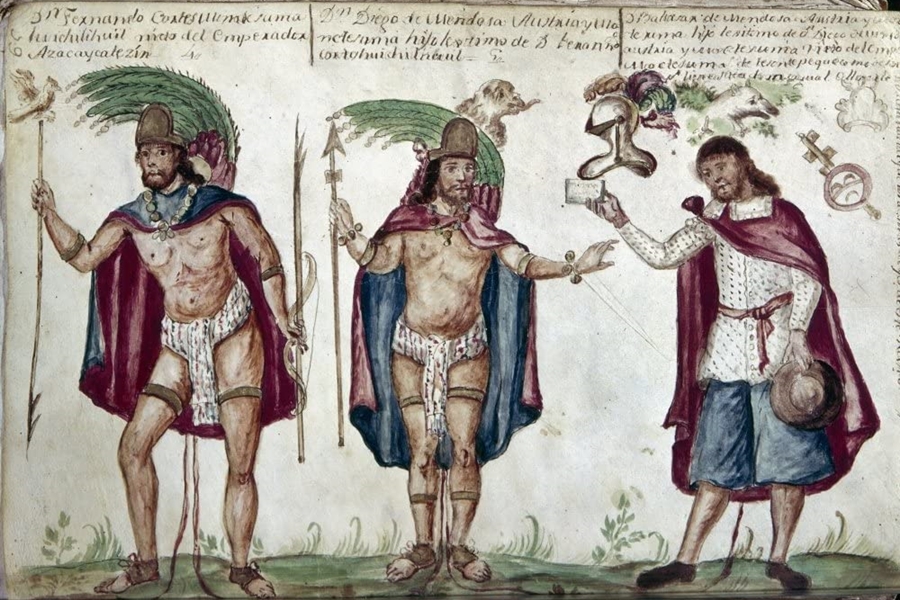


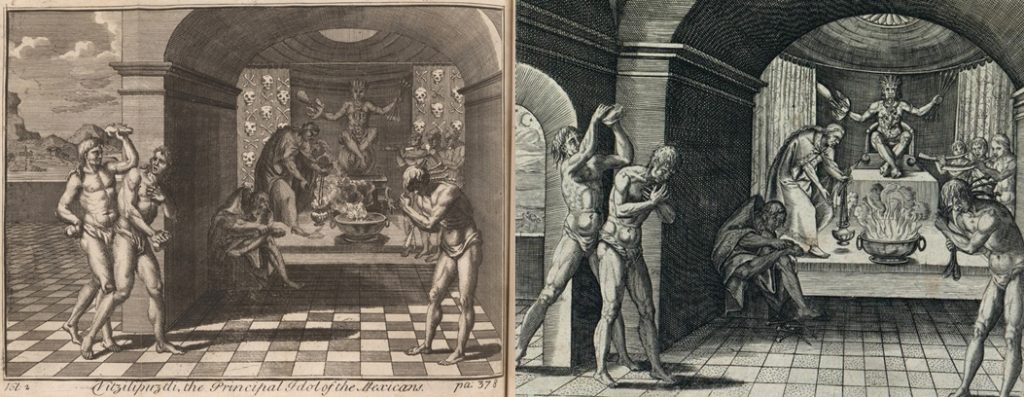
These two images below by Nicholas Eustache Maurin depict robust, muscular men and women. The women have very pale skin and facial features similar to the European Renaissance nobility. Some of the men have brown hair. The women have the physique of giant (7 foot plus) women. It looks like ‘The Powers That Be’ may have let this one slip through the net, as the women in these paintings are depicted with black hair, however, we can still see that these are not the small Mexicans. The artist is certainly not trying to depict short, skinny, dark-skinned Mexican people. This was created some time in the early 1800s. There were still a few artists around that were not totally brainwashed, or could at remember at least some Truths, in the first half of the 1800s.


Aztec Gallery (Click on Thumbnails):
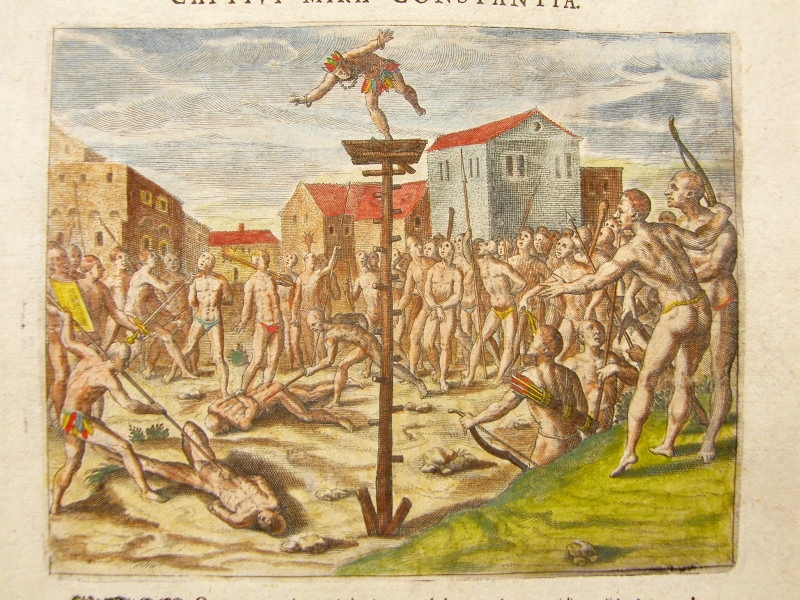
Above image found at this link: http://www.columbia.edu/itc/mealac/pritchett/00routesdata/1700_1799/compendia/debry/?C=M;O=A
Incas (Peruvians):
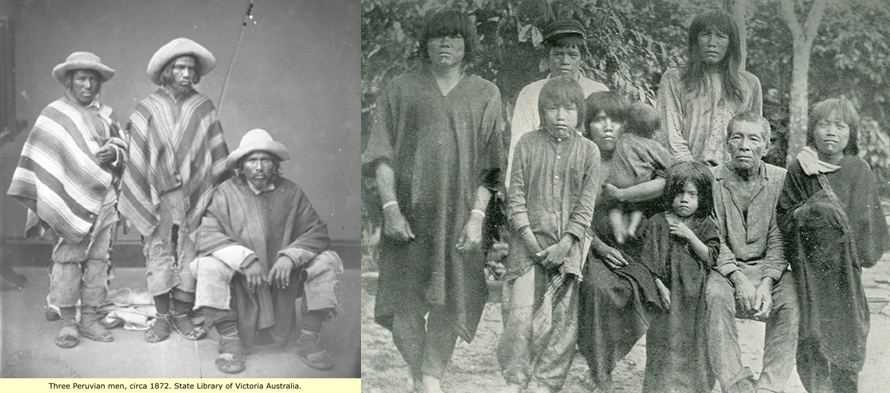
Girolama Benzoni published a book on his descriptions of his travels in the New World before De Bry published a book on them. Girolama met and observed many different tribes in the New World. Here are some images I found that were in the original publication. From looking at the text, it looks like these people depicted are Peruvians / Incas. They look like Europeans:
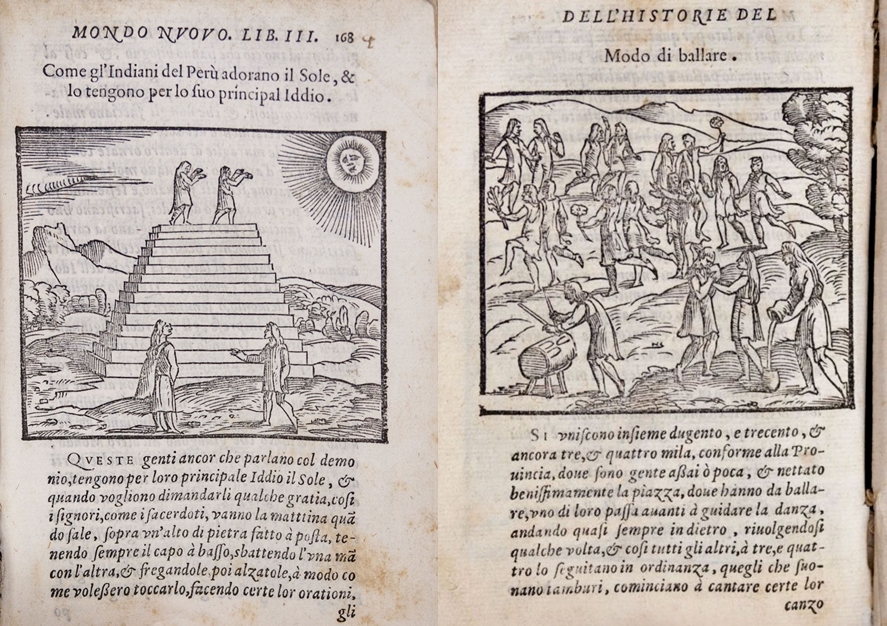
Elsewhere – this time in the Great Voyages publications – many of the Peruvians are shown to have shaved heads and large, muscular bodies – though the leader Atahualpa did not have a shaved head and had fairly long hair like the people depicted above:
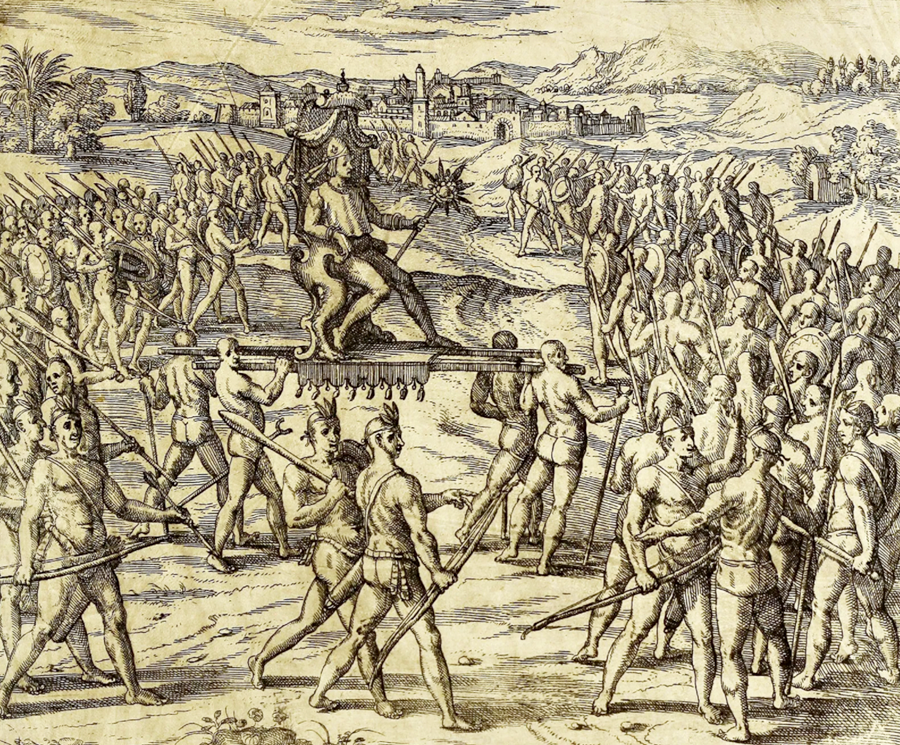
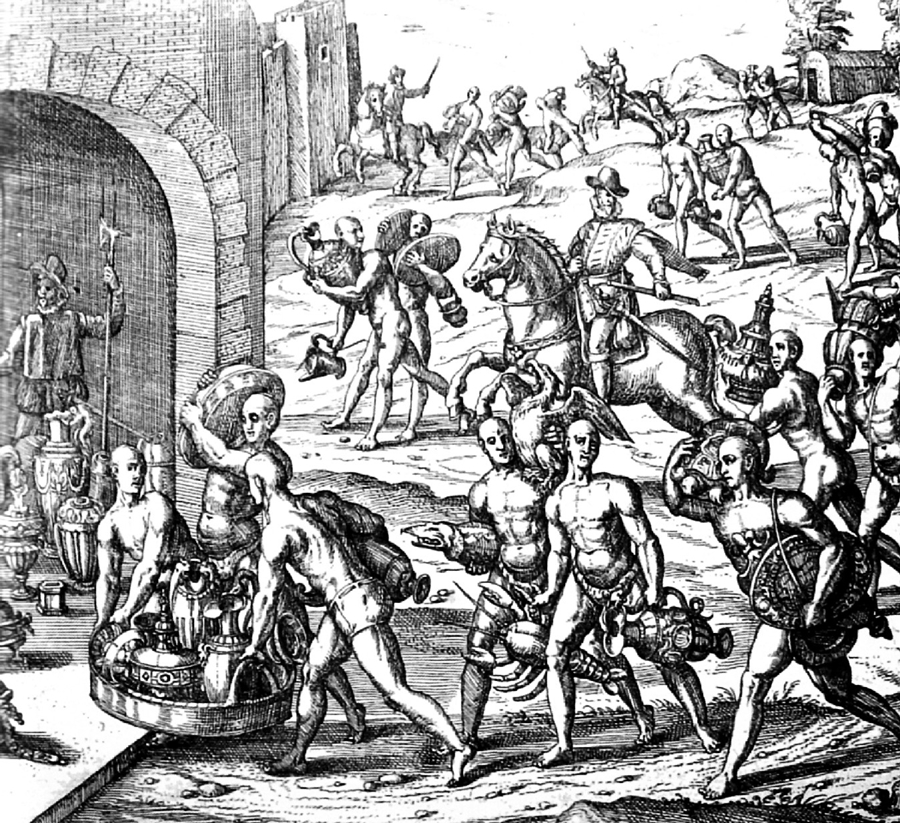

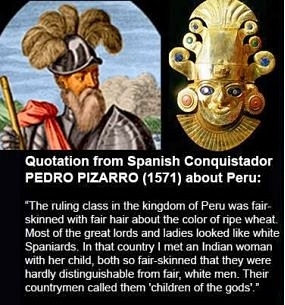
The Chachapoyas
The Legend of a White Peruvian Tribe.
In a remote corner of northern Peru, the ancient Chachapoya once held sway over a vast territory, today scattered with the distinctive remains of their trademark cliff tombs and hamlets of circular structures. Feared warriors and famed shamans, the Chachapoya flourished from around AD 800 until their violent conquest by the Incas in the 1470s.
Chronicler Pedro Cieza de Leon wrote of the Chachapoyas tribe:
‘They are the whitest and most handsome of all the people that I have seen, and their wives were so beautiful that because of their gentleness, many of them deserved to be the Incas’ wives and to also be taken to the Sun Temple. ‘The women and their husbands always dressed in woollen clothes and in their heads they wear their llautos [a woollen turban], which are a sign they wear to be known everywhere.’


Inca Gallery (Click on Thumbnails):
More Jacques Grasset De Saint Sauveur images (Thumbnails click to enlarge). I put some images of black people from this artist in the gallery, so as to show that the artist is happy to depict people as brown if they are brown:
Dutch Expeditions to South America (Guiana, Tierra Del Feugo etc) – Thumbnails, click to enlarge:
Mocha Island, Chile:
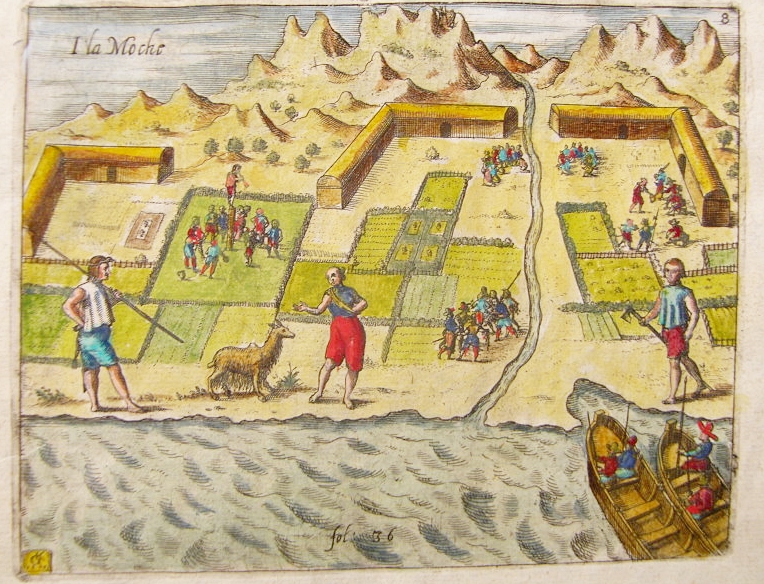
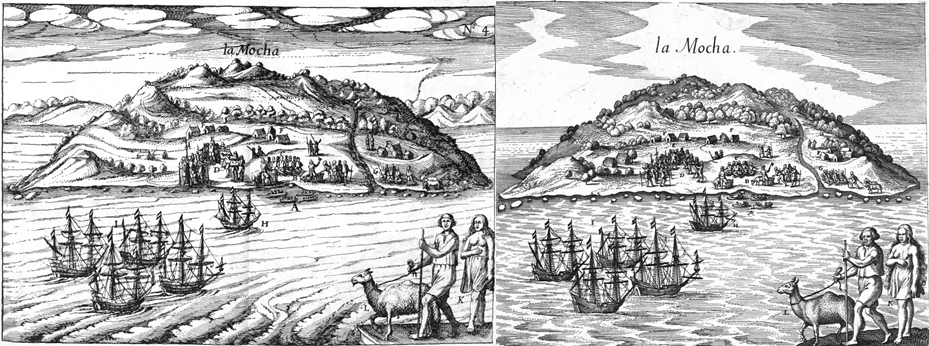
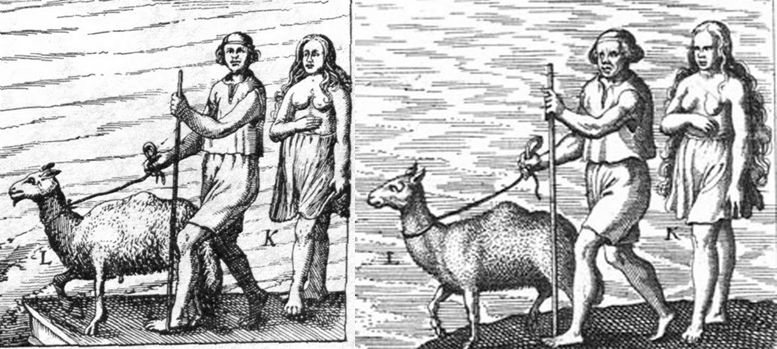
Some images from Johann Ludwig Gottfried’s publication of the New World Explorers Grand Voyages:
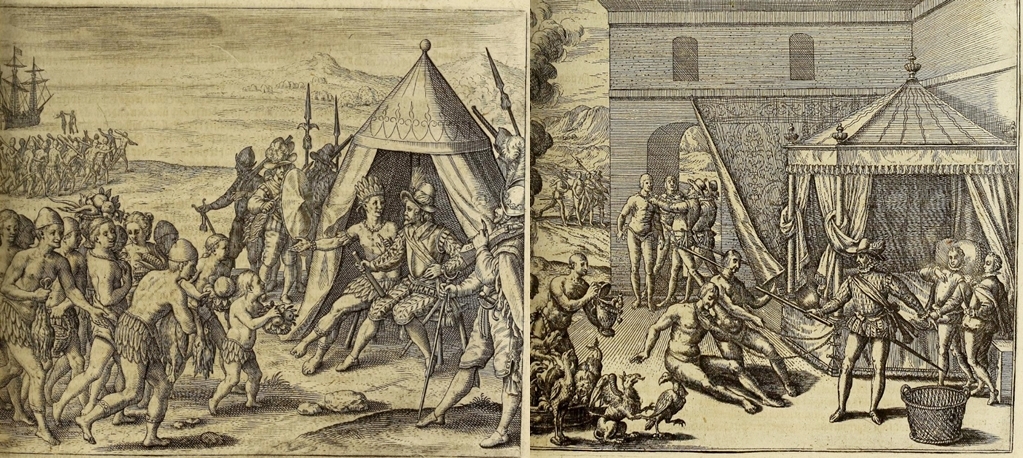
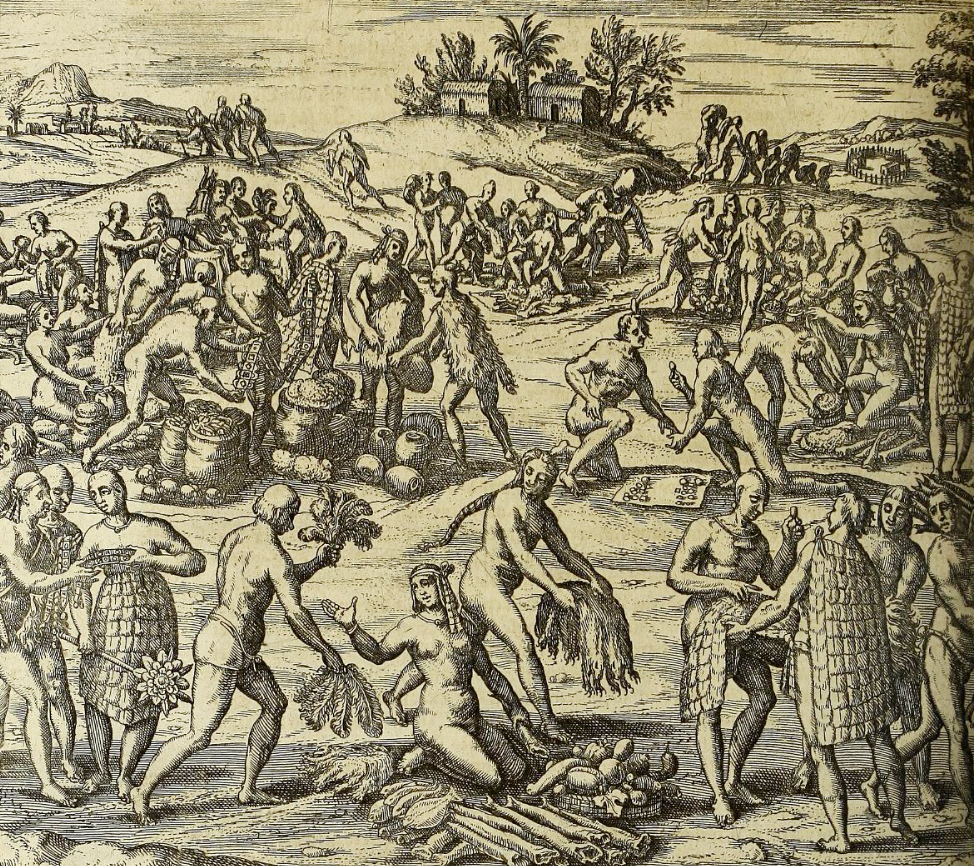

Some Links:
Grand Voyages List of Books: – http://international.loc.gov/service/rbc/rbdk/d031/inanalytics_america.html
(So many of the books can be viewed at the above link)
Americae pars quinta.: Benzoni, Girolamo, 1519:
https://archive.org/details/americaeparsquin00benz_2/page/n97/mode/2up
New World and American Histories:
https://archive.org/details/neweweltvndameri00gott_0/page/n17/mode/2up
Constitutes part one, sole issue of the French edition of Theodor de Bry’s Great voyages (Virginia):
https://archive.org/details/merueilleuxetest00harr/page/n101/mode/2up
Hans Staden original (not De Bry) https://archive.org/details/hansstadenvanhom00stad_0/page/22/mode/2up
Florida Memory • Theodor de Bry’s Engravings of the Timucua: https://www.floridamemory.com/discover/historical_records/debry/


























































































Hi E.A,
I must say these 4 articles of this new article series sure is fascinating and eye opening especially this article about White/Aryan natives in the Americas. Keep up the great work!
By the way, here’s some great videos of Andromeda Gerät spaceships that were spotted on film. You can add these in either one of the 5 Ufology Explained article series.
https://streamable.com/dadbc5
https://streamable.com/ah7xjk
https://streamable.com/mt1ydb
https://streamable.com/pplyvd
https://streamable.com/oxwje9
https://streamable.com/368bwj
https://streamable.com/j0hs5l
https://streamable.com/aikcml
https://streamable.com/2rnnpg
https://streamable.com/ddt976
Also, can you do an additional article or just an addition section about crop circles to the Ufology Explained article series?
In August 8, 2015 a crop circle appeared in Ox Drove Nr. Bowerchalke Wiltshire, United Kingdom. The shape and design is of the classic Sonnenrad/Schwarze Sonne (Sun Wheel/Black Sun) symbol.
Here’s a video overview of the Sonnenrad shaped crop circle.
https://youtu.be/c0TINnRdSw4
The Reichsdeutsche Part 8: “Aliens” and crop circles.
https://fliegende-wahrheit.org/2019/07/31/die-reichsdeutschen-teil-8-aliens-kornkreise/
Excerpts from the article above:
“As in many other sighting and contact cases, where the “aliens” are suspiciously often described by those affected as TALL, LIGHT-HAIRED and BLUE-EYED people, the same picture emerged in the ‘Schmidt case’.
In UFO research, the often BLOND figures from space who apparently speak GERMAN are usually referred to as ‘Venusians’. The fact that many UFO experts still believe this nonsense, although the truth is already at their feet, says a lot about their alleged ‘expertise’
Gilbert Sternhoff describes the crop circles as manifestations of the Third Power, which I believe is absolutely correct. The sometimes gigantic ‘grain images’, which have already triggered a worldwide press hype, bring their creators, i.e. the UFO pilots, a lot of sympathy and admiration everywhere. Some also see hidden messages in it.
As a ‘PR gag’ by the Reichsdeutsche, the crop circles are definitely an excellent idea.
Such images also appear suspiciously often in the area of Celtic places of worship, which suggests an affinity of the originators to the Germanic-Celtic history of Old Europe.”
An analysis of a crop circle that appeared at Etchilhampton Hill near Devizes, Wiltshire, dated 24/07/22
https://fliegende-wahrheit.org/2022/07/31/zwei-kornkreise-unter-der-lupe/
Nice to see you are still creating articles. I recall renegade making an article on aryans in the americas and it is just some really interesting stuff and it is sad what has happened to them. Cheers, Diego Tesoro
Hi E.A. Must say, I am thoroughly enjoying the knowledge relayed in this series, even though it is quite depressing when you take into account what was done to all who are native to this world. Innately, I’ve always known modern society is not how a world should be functioning. This is not living but existing in a nightmare world of chaos and ignorance.
You’re right about how the people of ‘ancient Americas’ are not properly depicted ethnically. Some books mention this but most do not, obviously. Peter De Roo is an author I’ve read. Then there’s Barry Fell, L. Taylor Hansen and a few others. All are dead. And, even with the aforementioned, there’s some misinformation (maybe by mistake???)
Wanted to include how in Amerindian history, they differentiate between ‘Children of the Sun’ and ‘The People’. For example: Na Dene (Navajo), Hopitah Shimunah (Hopi) etc. simple means ‘The People’. While the original names for Blackfoot, Mandan, Anasazi, the Mississippi mound builders (and a few others) meant ‘Children of the Sun’. You will find that most Amerindian tribal names of today simply mean ‘The People’. And, in general, their origin story involves off planet beings bringing them here, whether from the Sky People or coming through a portal underground (Ant People).
Also, the name Anasazi roughly translates to ‘Ancient Enemy’. (they now are saying it means ‘ancestors,’ but that’s not the original translation). The Navajo gave that name to them. It makes sense when you add your research. For me, your info clears up why Navajo elders cooperated with the U.S. military during WW II (re: Windtalkers and codes). I used to think they were just extremely naive and ignorant about what that war was about (even though they’re supposed to be connected with the natural spiritual world…go figure). Now, it makes a bit more sense.
Circling back…’The Children of the Sun’ were most likely descendants of those tall (robust) people who harnessed the Sun’s benefic energies in various ways (as you discuss in your material). While ‘The People’ could be a mix of those who were brought here by the Sky People, Ant People etc. Just a thought.
The last tidbit I like to add is the discovery a while back regarding tall White/European-like mummies found in Egypt. They were buried in a manner that relayed an interesting hierarchy. The blonde mummies were in one section while the red haired mummies were in another. It was said the red haired people were the leadership class while the blondes were the warrior class. I forget the name of the site but the modern Egyptians have turned the area into a waste dump. Pretty disrespectful. Tells a lot about the so called modern ‘Egyptians’. Not the same people.
Keep sharing your knowledge. You are providing excellent cohesion to a greatly convoluted situation (topic).
SB
I have been wondering about this question. In North America there were numerous cities of old world architecture built by the tall White people. Why were the tall White Indians living in nature in a primitive way (as the art work shows) when there were numerous great cities there. Who built the cities? Were they a different group of tall White people?
Hi Robert
It is difficult to know the full Truth. There are some images of some of the White giants using the Old World buildings (For example, the Aztecs were depicted as using them and seemed to have a somewhat more advanced civilisation than others – and I think it was the same for the Incas as well). But there also some strange occurrences – with populations of fairly primitive White Indians living not far from some of the large Old World cites… Cities that would have been there at the same time as them. So it seems like we are probably not getting the full Truth.
All I can do is show people what was in the various New World Voyage books. There are definitely no images of small, skinny, dark-skinned, red Indians – those populations were clearly added to the planet at some point in the 1800s
I am pretty much certain that the Old World cities were not built by humans. It very much looks like the Bipedal Reptilians built these cities for humans to live in. Humans were like livestock to them.
Hope that helped.